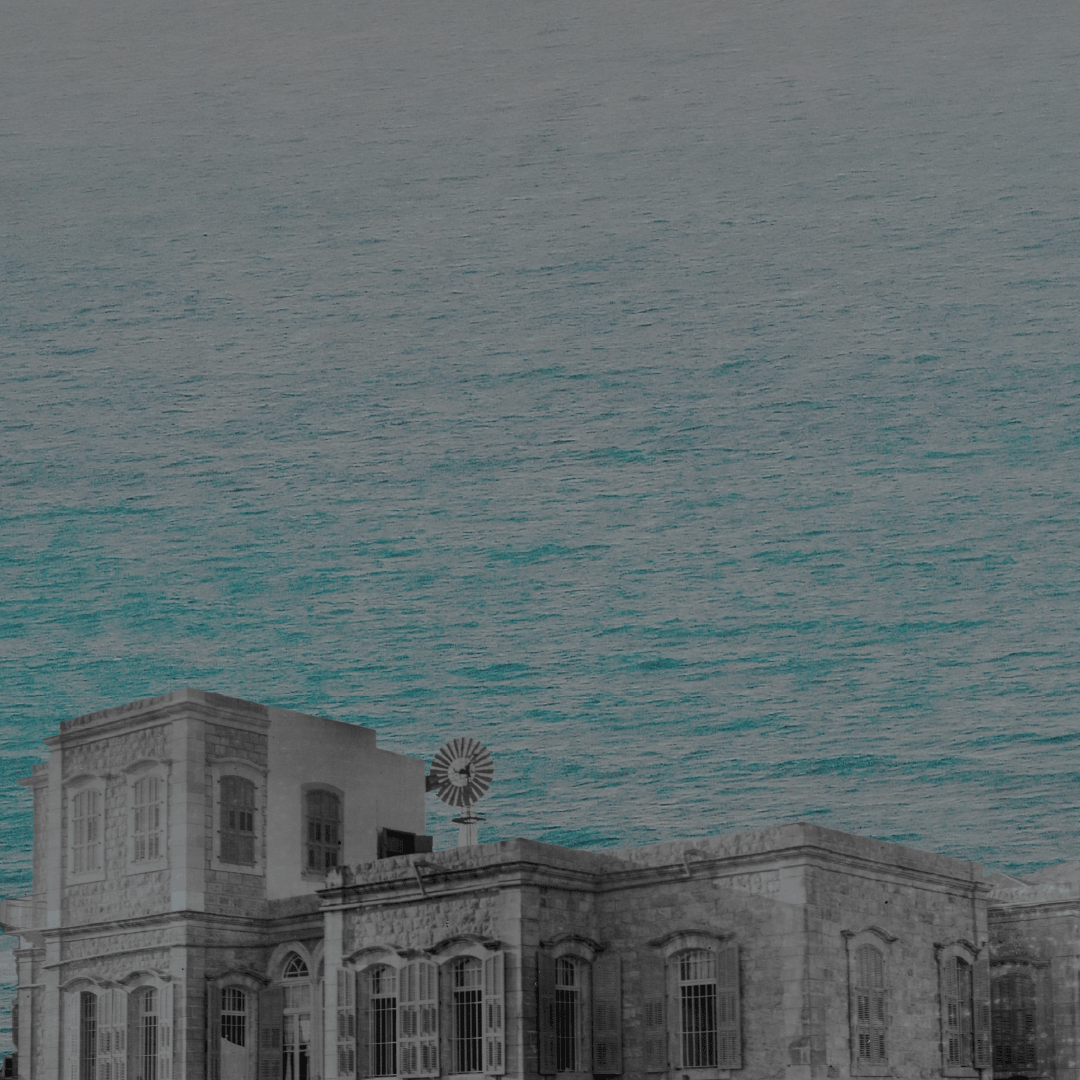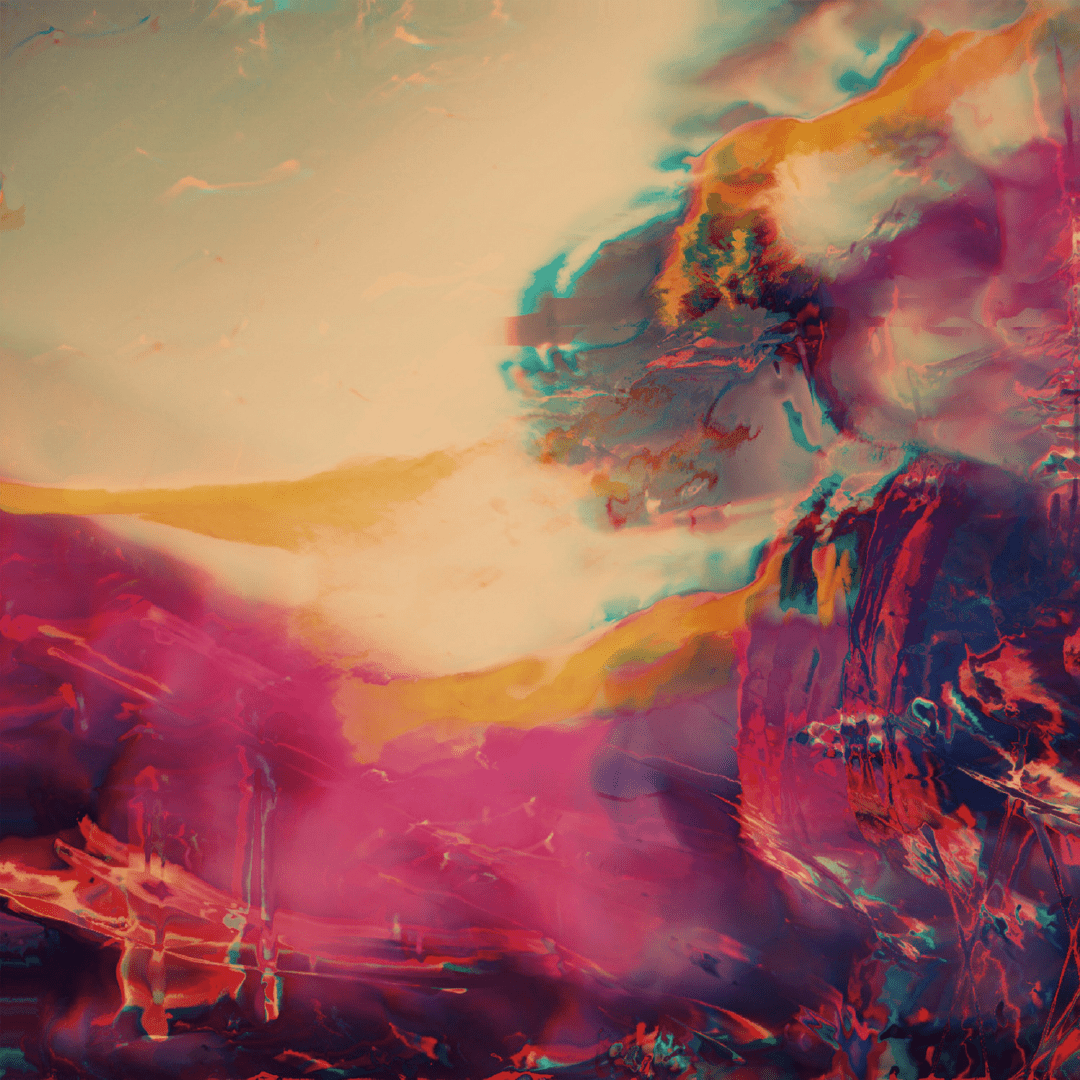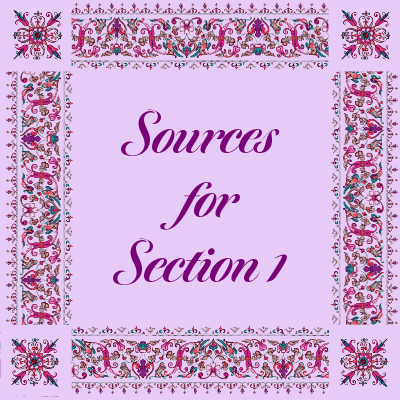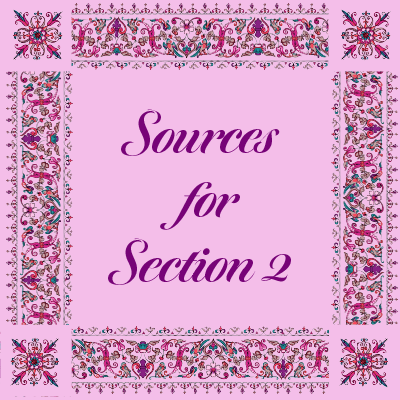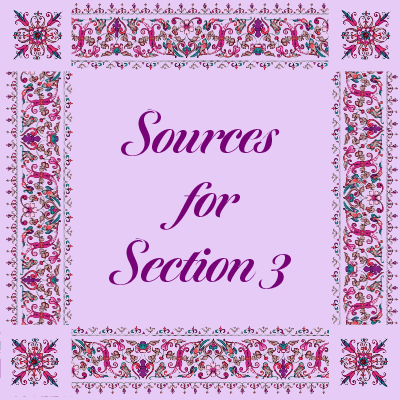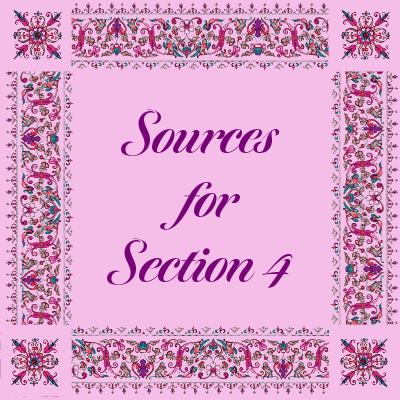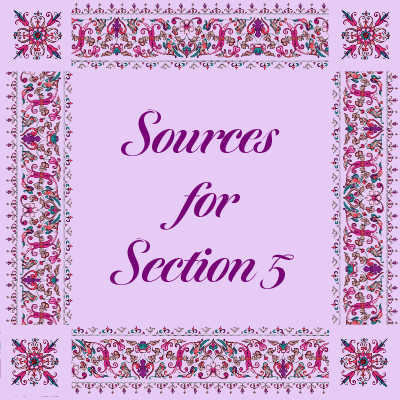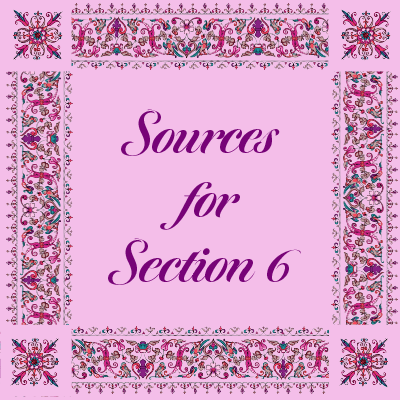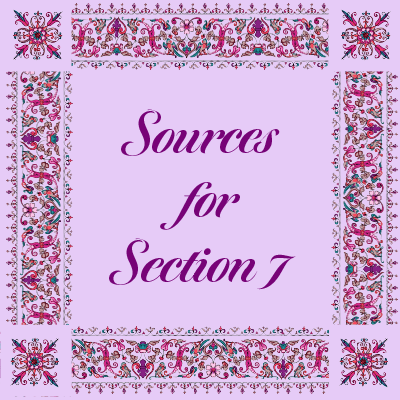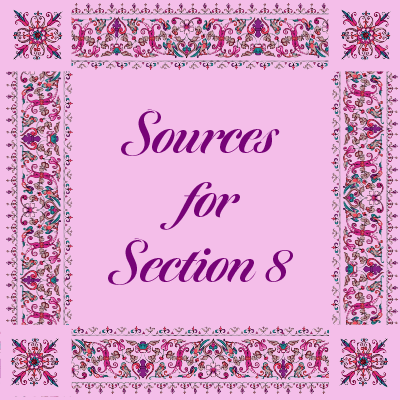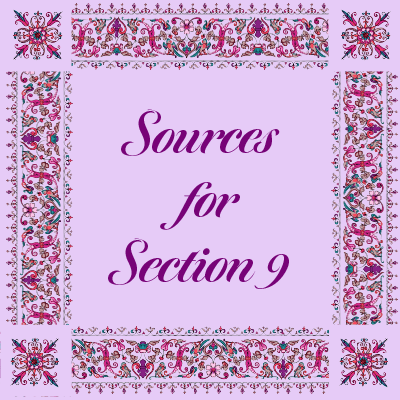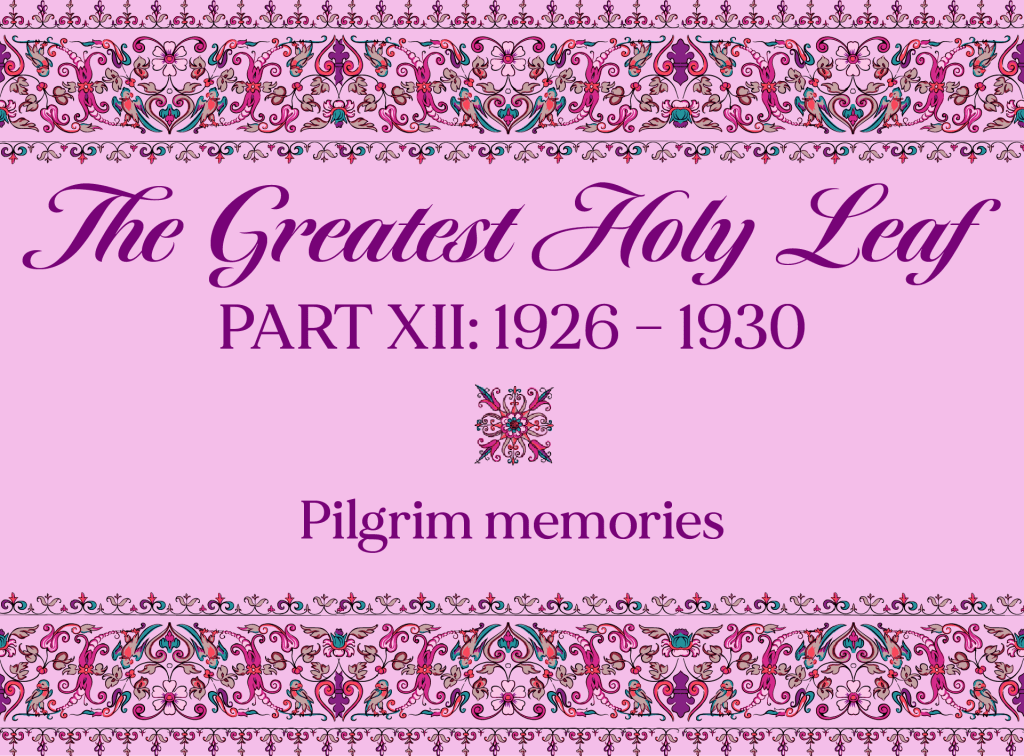
Written and illustrated by Violetta Zein
This part covers the life of the Greatest Holy Leaf from the age of 80 in 1926 to the age of 84 in 1930.
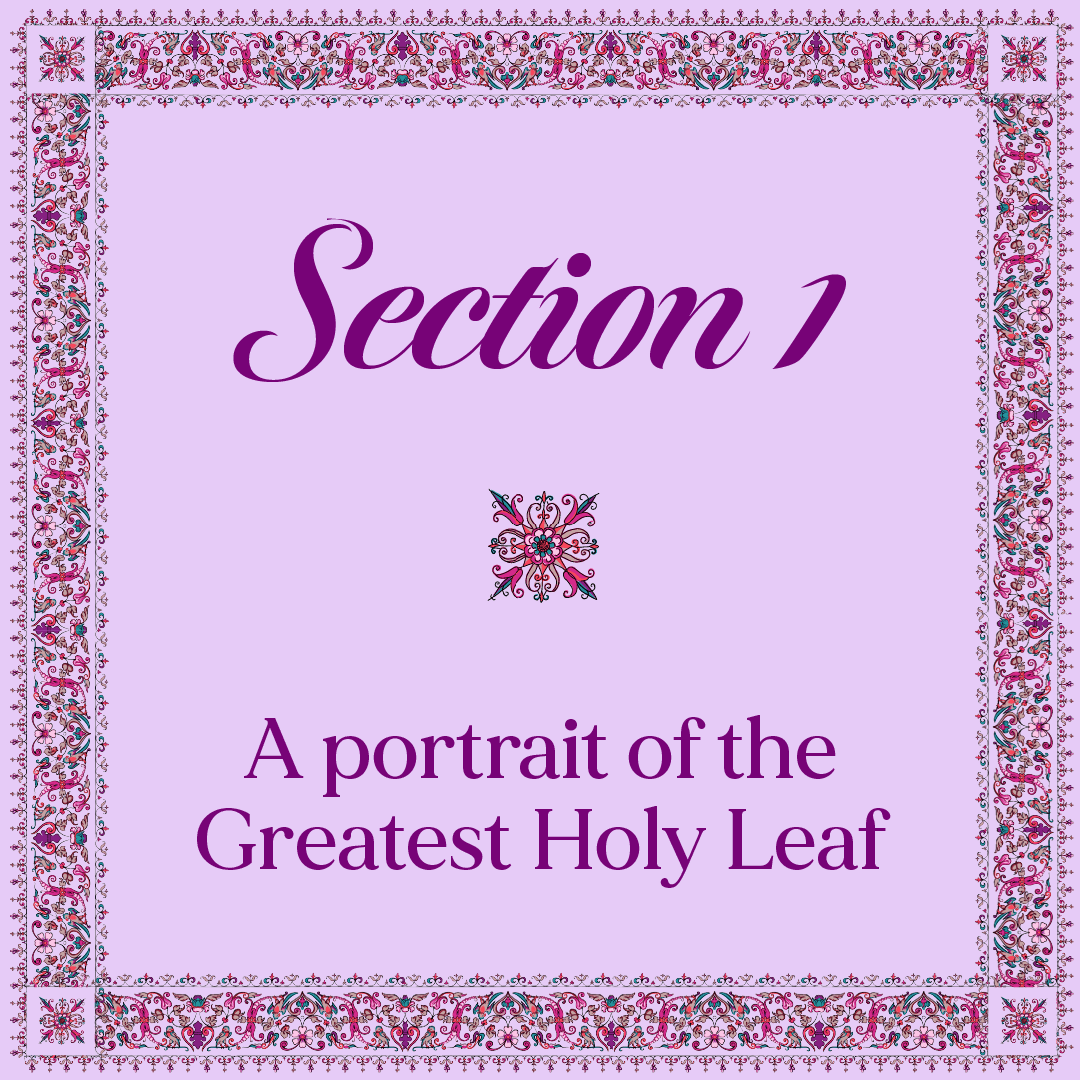
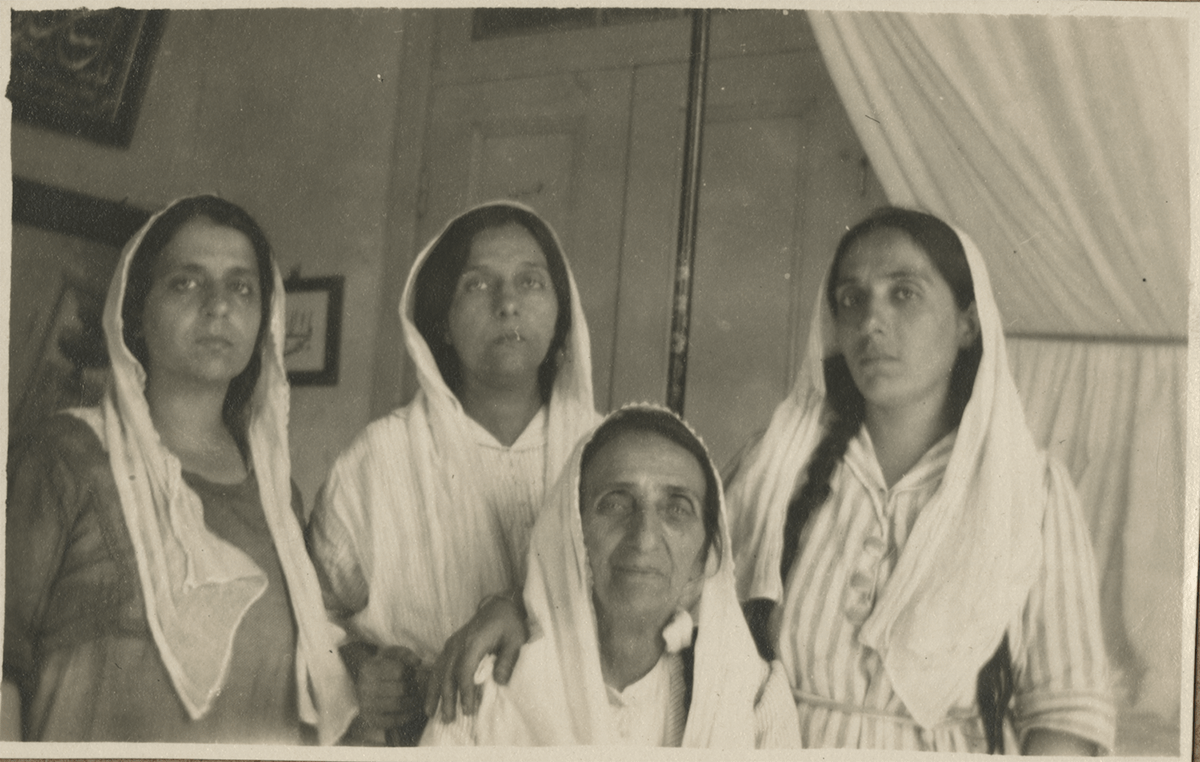
The Greatest Holy Leaf in the center, surrounded by three of her nieces, the daughters of 'Abdu'l-Bahá, from left to right: Munavvar Khánum, Ḍíyá‘íyyih Khánum—the mother of Shoghi Effendi—and Túbá Khánum with her hand around her aunt. © United States National Bahá'í Archives, used with permission.
Bahíyyih Khánum exuded a heavenly love not of this world, and so those who were blessed enough to enter her presence felt a spiritual experience, as if their souls were momentarily hushed and exalted at the same time. She was everything that made hearts wonder, that made souls soar, that revealed the depth of the heart, she was like the miraculous coming of the spring.
The Greatest Holy Leaf’s thoughtfulness, her generosity, her loving kindness, and her complete dedication to the things of the spirit never flagged until the day she passed away.
The power of the Greatest Holy Leaf resided in her forgiveness and in her gentle, patient, and loving response to any cruelty or unkindness.
Forgiveness, in its spiritual essence is to be hurt and forgive, but the Greatest Holy Leaf went beyond this: she had the power to understand with the greatest empathy, and not be hurt in the slightest.
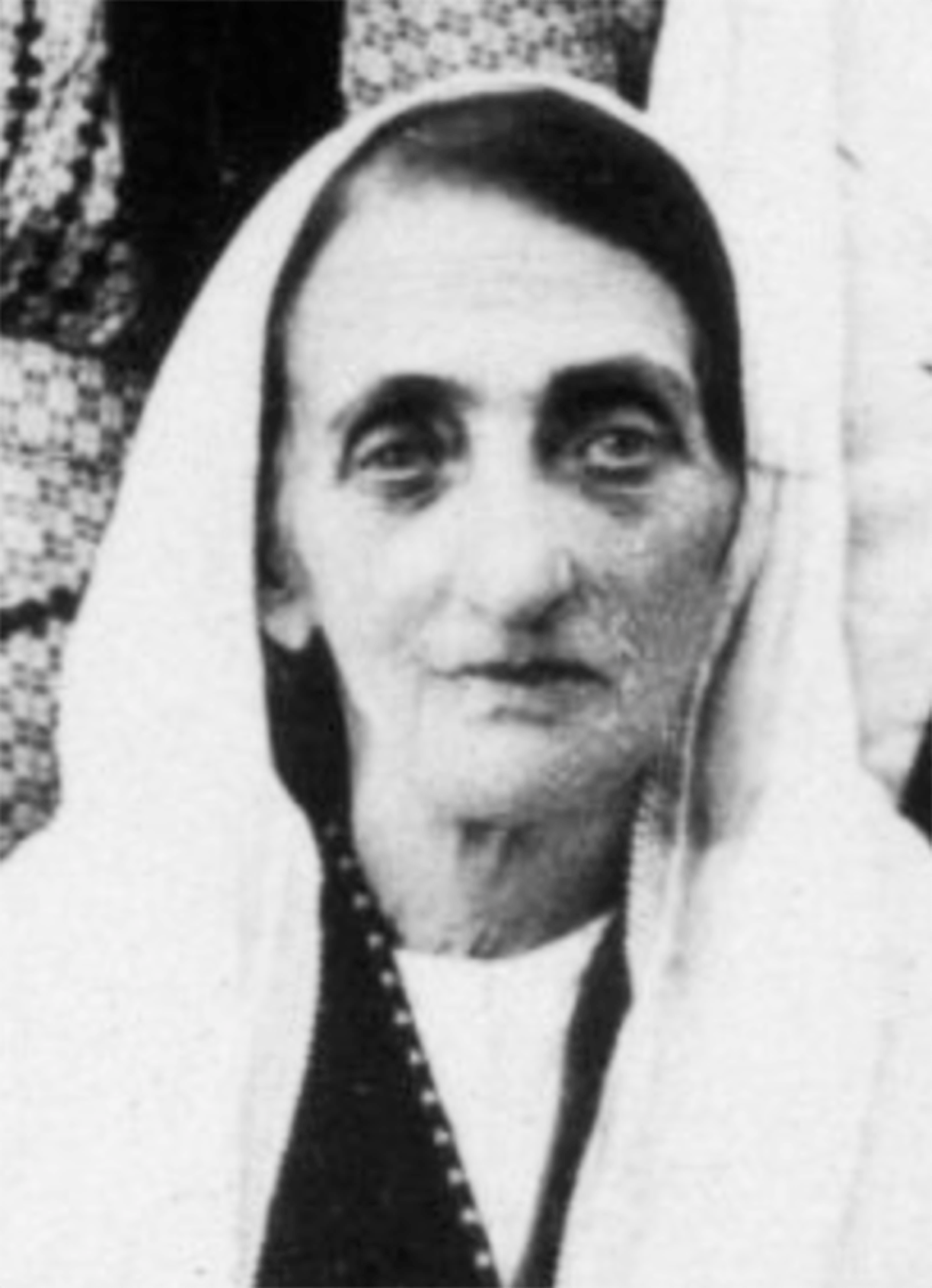
Cropped photograph of the Greatest Holy Leaf. Source: Bahai Biblio.
The Greatest Holy Leaf’s love was completely unconditional, it could pierce any mask a person was trying to hold up, and she had the rarest kind of tenderness: the ability to instantly detect any need a person had. The Greatest Holy Leaf had lived such a hard life and was possessed of such spiritual perfections that she had a celestial understanding of the miseries of the human condition, and an ability to validate both the sufferer and their deep pain.
The magic of the Greatest Holy Leaf was her sweet and selfless presence, the spiritual atmosphere that surrounded her and which had the ability to transform lives, like alchemy, being near her changed a person from copper to gold.
Those who entered her presence felt such a happy feeling of warmth and contentment, and they only later realized that that warmth and contentment had been the wrapping of a much deeper gift, a joy that penetrated to the deepest part of their soul.
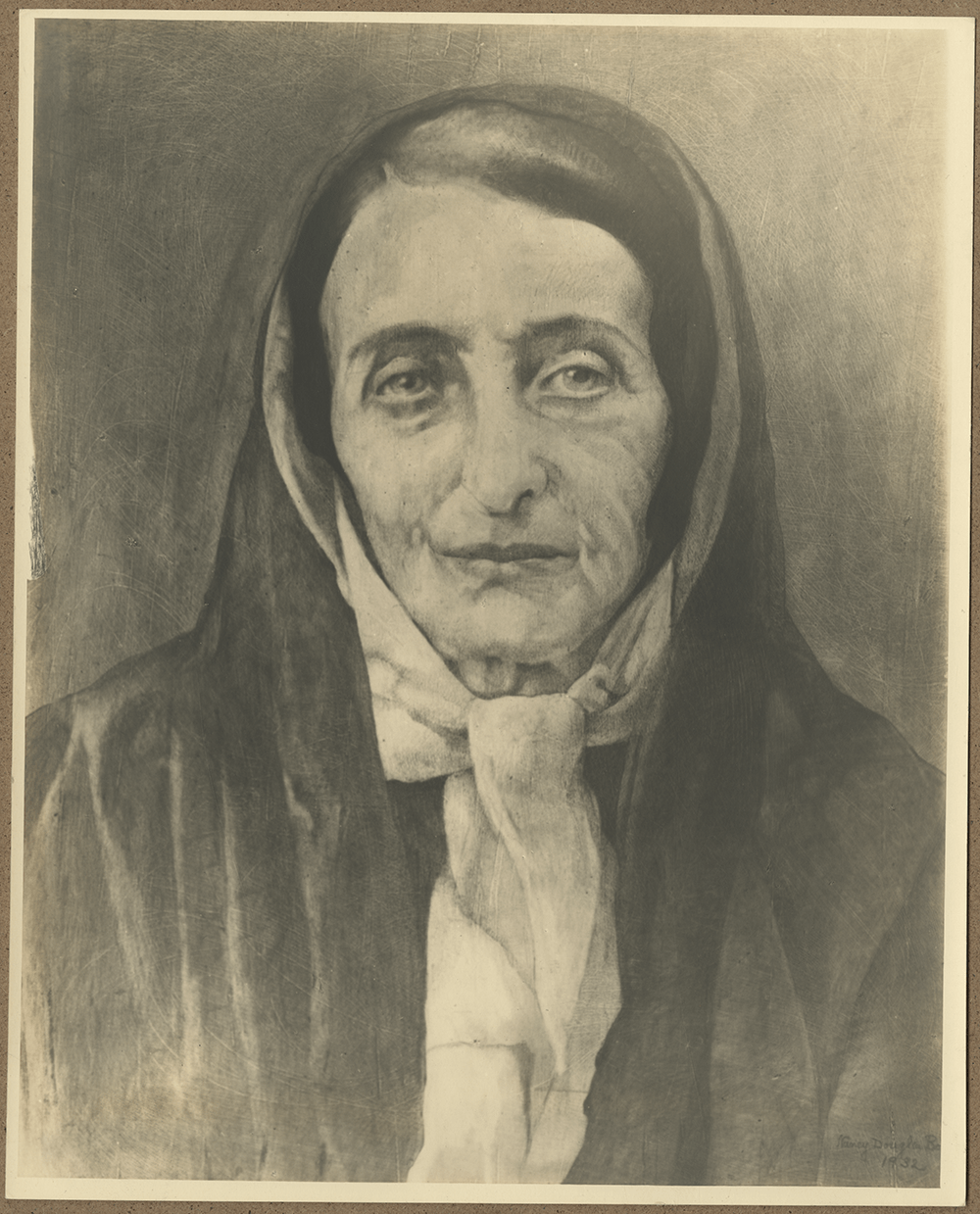
Anonymous portrait of the Greatest Holy Leaf. Information stamped on the back of this photograph reads:
“Dorothy Jarvis’s studio, 358 Washington Street, Brookline, Mass.”© United States National Bahá'í Archives, used with permission.
The Greatest Holy Leaf was also a deeply resilient soul.
She had lived through the shocks and upheavals of her life with immense dignity and did not run counter to obstacles. This was not a sign of quiet and long-standing suffering, this was Bahíyyih Khánum’s steadfastness in the Covenant of Bahá'u'lláh, and her quiet awareness of for the forces that operated around her.
In this way, the Greatest Holy Leaf always moved with the power of the Covenant: she was in tune with the rhythm of the Faith, the wider perspective of the Cause of Bahá'u'lláh and her role in it, and she was always focused on the ultimate goal. The Greatest Holy Leaf was supremely confident in the ultimate triumph of the Cause.
One of the Greatest Holy Leaf’s most significant attribute, her resilience, was one of her most enduring and distinguishing characteristics.
Bahíyyih Khánum endured an entire lifetime of suffering and difficulties, and while they indeed left deep marks on her body and her face, they never broke her or affected her joyful spirit, they never dampened her hopefulness, and they certainly never undermined her faith in the future.
The Greatest Holy Leaf never complained, and was completely incapable of either bitterness, anger, or impatience, even in the depths of calamity. Not only did she make the best of any situation she found herself in, she had the ability to find the best in any situation, even heartbreaking ones, and find gems of enduring wisdom in any difficult situation she endured.
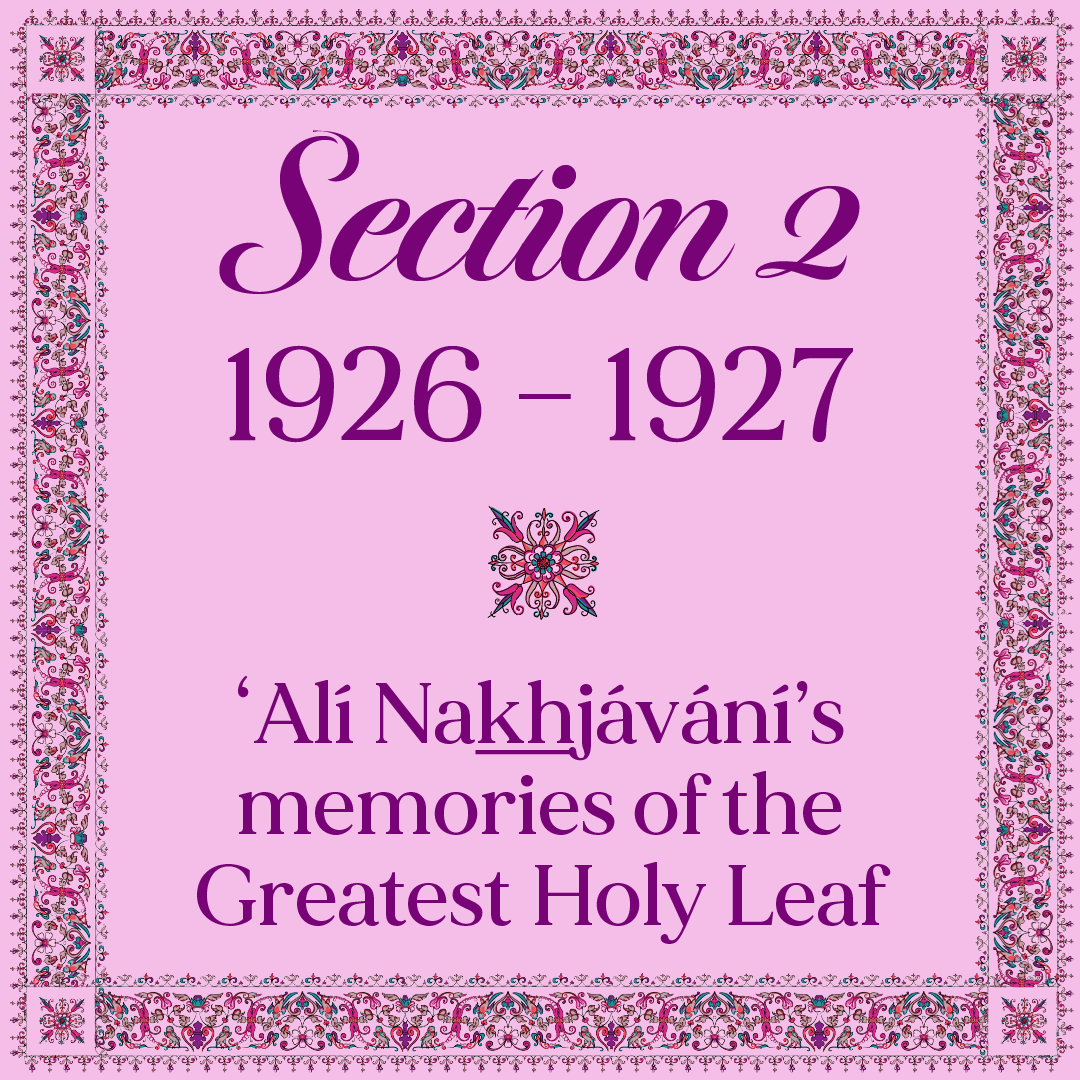
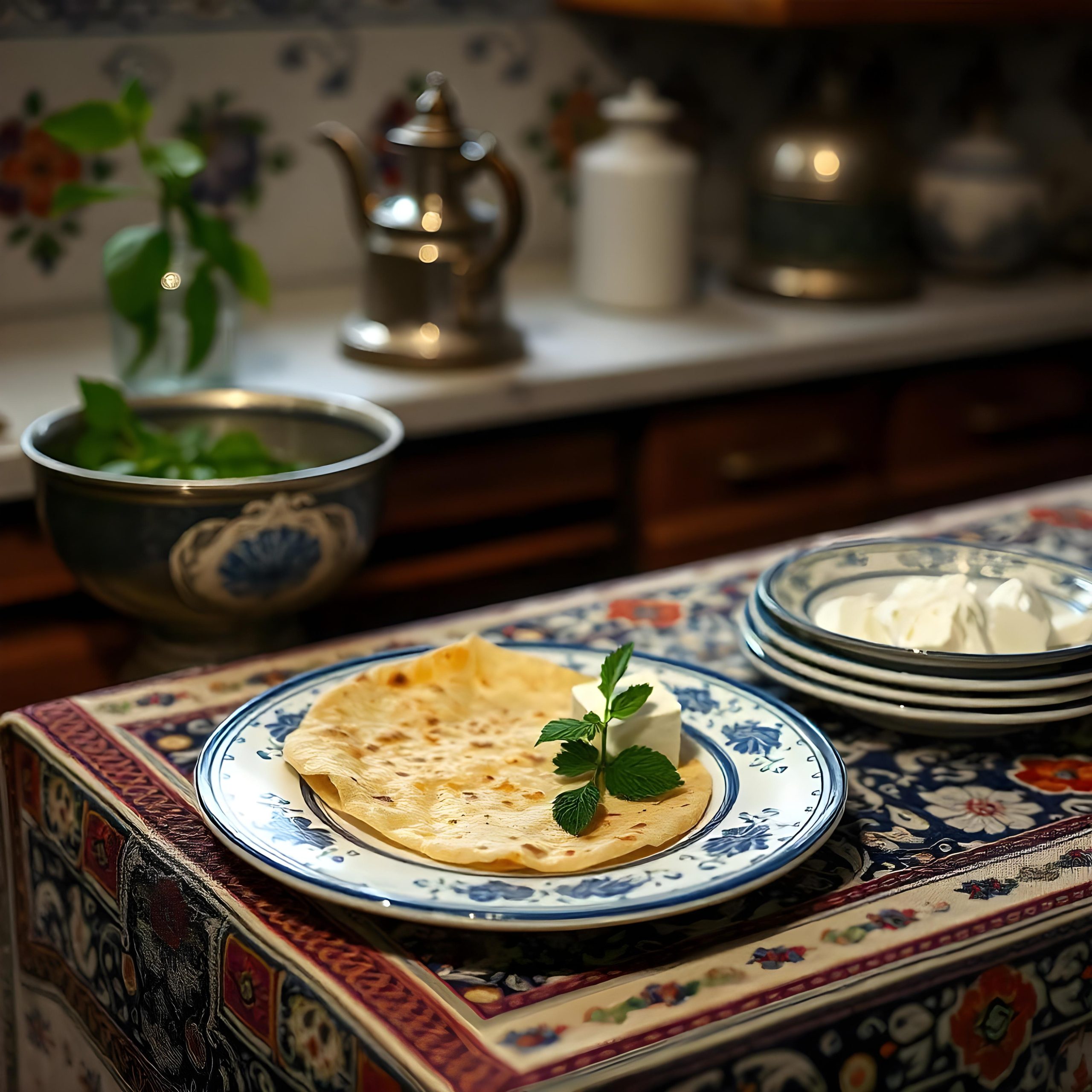
AI illustration generated by Pikaso AI.
The “Mouthful of Khánum” had been famous among the children in the household of the Holy Family since the time the Greatest Holy Leaf’s first grand-nephews and grand-nieces had been born in the late 1890s.
The rowdy, happy, talkative children always ate lunch with the Greatest Holy Leaf, and every single child, no matter what was being served, always insisted that when the Greatest Holy Leaf gave them a spoonful of her own food, it always, always tasted better than everything else.
The children had come to call this special treat and gesture of love on the part of the Greatest Holy Leaf as “The Mouthful of Khánum.” When Shoghi Effendi was a child, thirty years before, the “Mouthful of Khánum had already been famous.
The Nakhjávání family had moved to the Holy Land in 1922, and over 20 years after Shoghi Effendi’s own childhood, the “Mouthful of Khánum” was still a prized treat.
This story is about that sweet, delicious, loving little mouthful.
In 1926 or 1927, when ‘Alí Nakhjávání was about five or six years old, he came to the Master’s house with his mother Fáṭimih Khánum on a hot afternoon, probably during the summer.
The door of the Master’s house was open and the Greatest Holy Leaf was seated next to the big round table which is still there in the hall at 7 Haparsim.
Next to the Greatest Holy Leaf was a bubbling samovar, and seated around her were Munírih Khánum and her niece, the daughters of 'Abdu'l-Bahá.
‘Alí Nakhjávání and Fáṭimih Khánum reached the hall and stood there and bowed.
Bahíyyih Khánum, who was having tea, beckoned them to come in.
As ‘Alí approached the Greatest Holy Leaf, he noticed that she was eating a traditional middle-eastern meal: fresh flat Arabic bread, white cheese and fresh mint.
The Greatest Holy Leaf had prepared a mouthful of the delicious ingredients in her hand, and as ‘Alí and his mother approached, she asked the young boy to come to her.
Then, the Greatest Holy Leaf asked ‘Alí Nakhjávání to close his eyes.
He did.
Then she said:
Open your mouth.
The Greatest Holy Leaf put the mouthful of delicious bread, cheese and mint in ‘Alí Nakhjávání’s mouth.
The experience of “the mouthful of Khánum” was so vivid in ‘Alí Nakhjávání’s mind, that for the next 56 years of his life, he could instantly recall the taste of the fresh mint, bread and cheese from the hand of the Greatest Holy Leaf.
For half a century, ‘Alí Nakhjávání would feel and taste the “mouthful of Khánum” every time he recalled the memory of that hot afternoon in the Master’s House in Haifa.
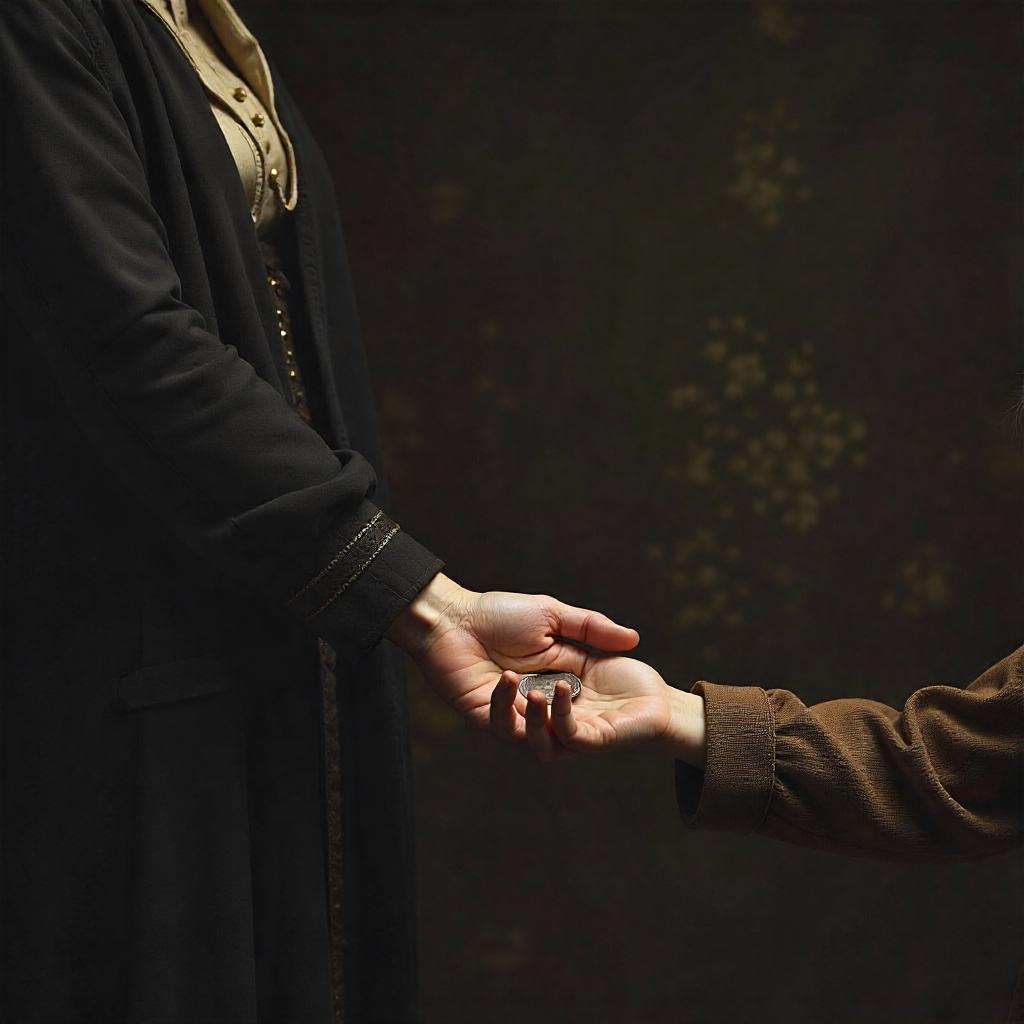
AI illustration generated by Pikaso AI.
In the late 1920s British currency was in use in British Mandate Palestine.
One day, Jalál Nakhjávání was leaving the presence of the Greatest Holy Leaf, and before he left, Bahíyyih Khánum gave him a little gift, saying:
Jalál, here is a shilling. Half for you and half for your brother.
Jalál was confused:
But Khánum, how can I break this coin?
Jalál’s innocent reaction made the Greatest Holy Leaf laugh.
She called Jalál back to her and gave him another silver coin, saying:
This one is for your brother.
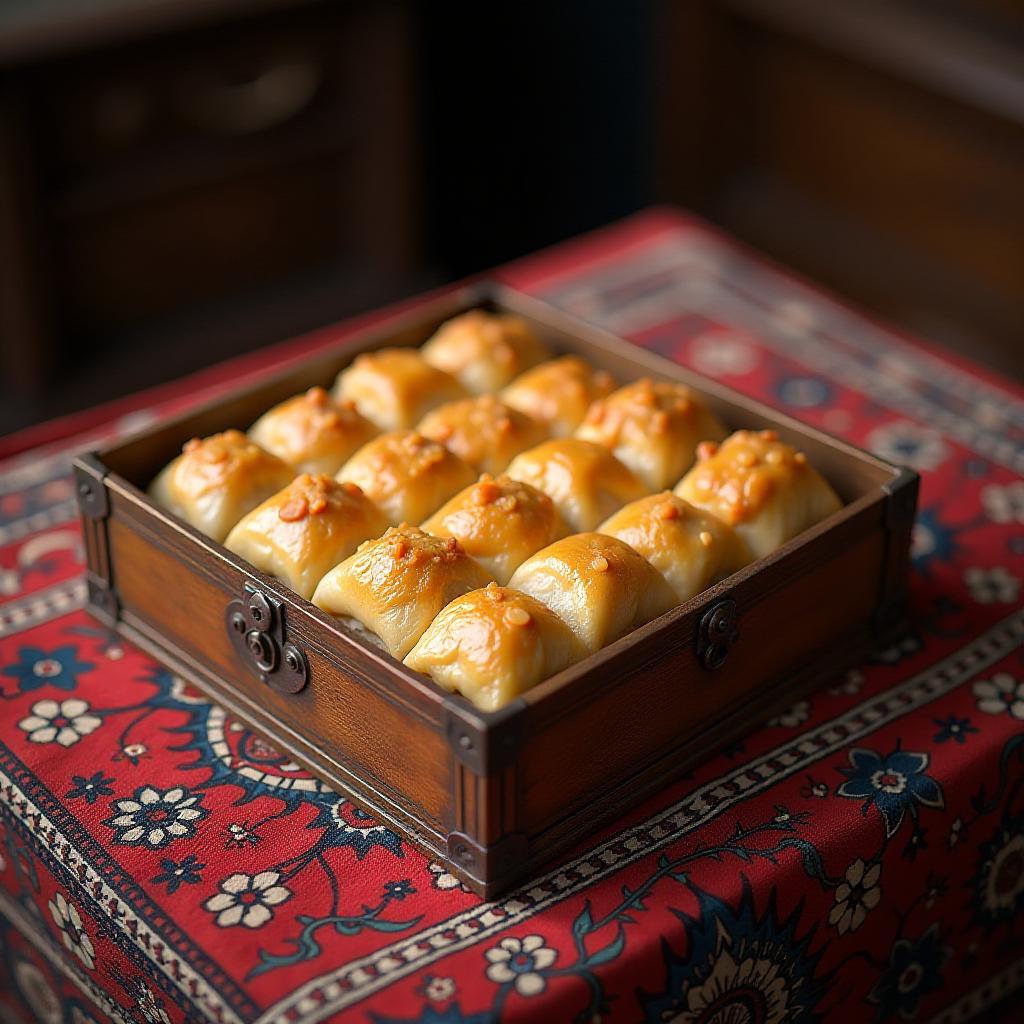
AI illustration generated by Pikaso AI.
Children adored the Greatest Holy Leaf, and the Greatest Holy Leaf adored children.
In the late 1920s, ‘Alí and Jalál Nakhjávání had many opportunities of eating sweetmeats, nuts, cookies and other goodies in the room of the Greatest Holy Leaf in the House of the Master.
By this time in her life, the Greatest Holy Leaf was already in her eighties and she was often tired, so when the children came into the room, she would be seated or in bed.
But still, the Greatest Holy Leaf would tell the boys:
Bring that box from under the mandar. Bring it out, that‘s right, bring it out. Now open it. Take one for yourself and give one to your brother.
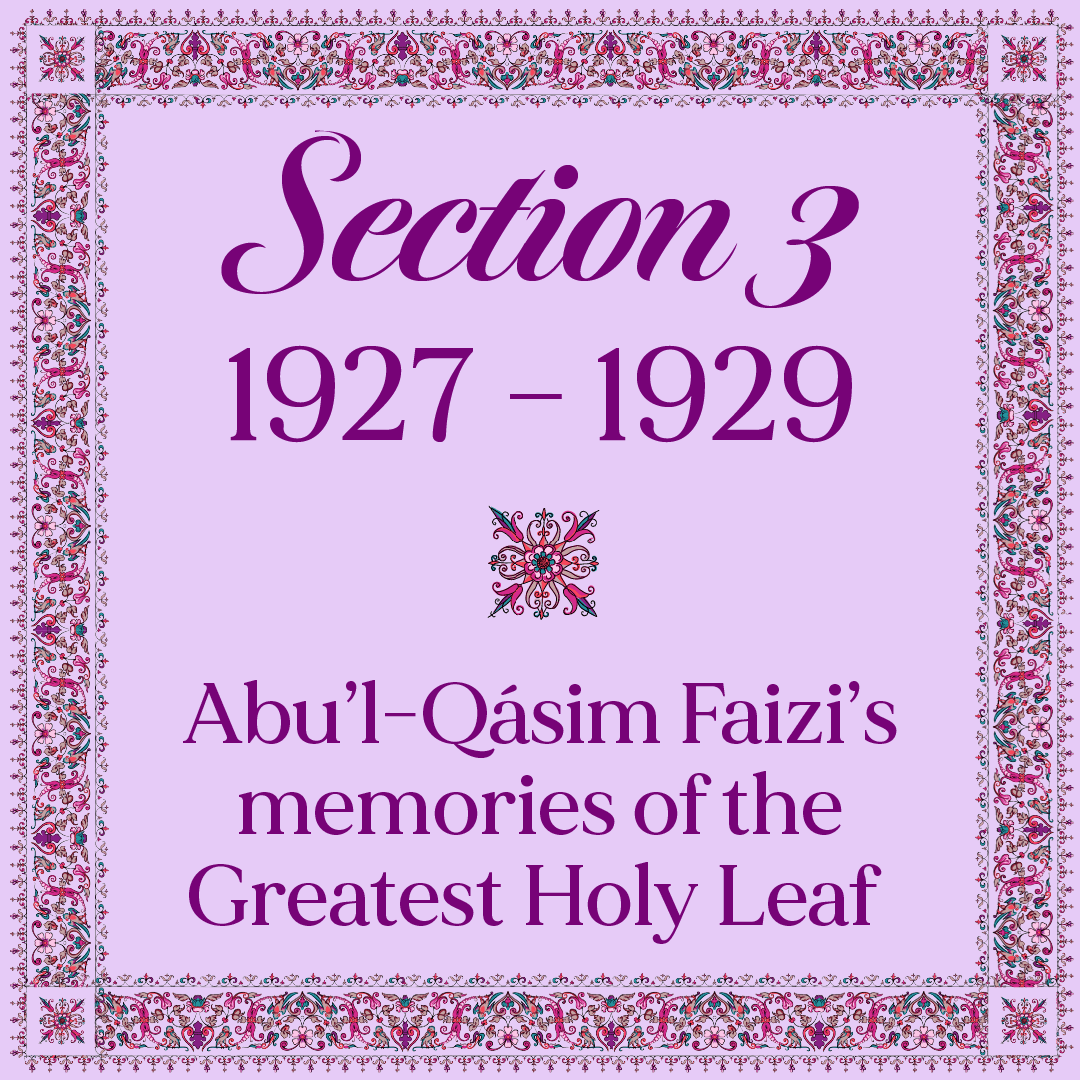
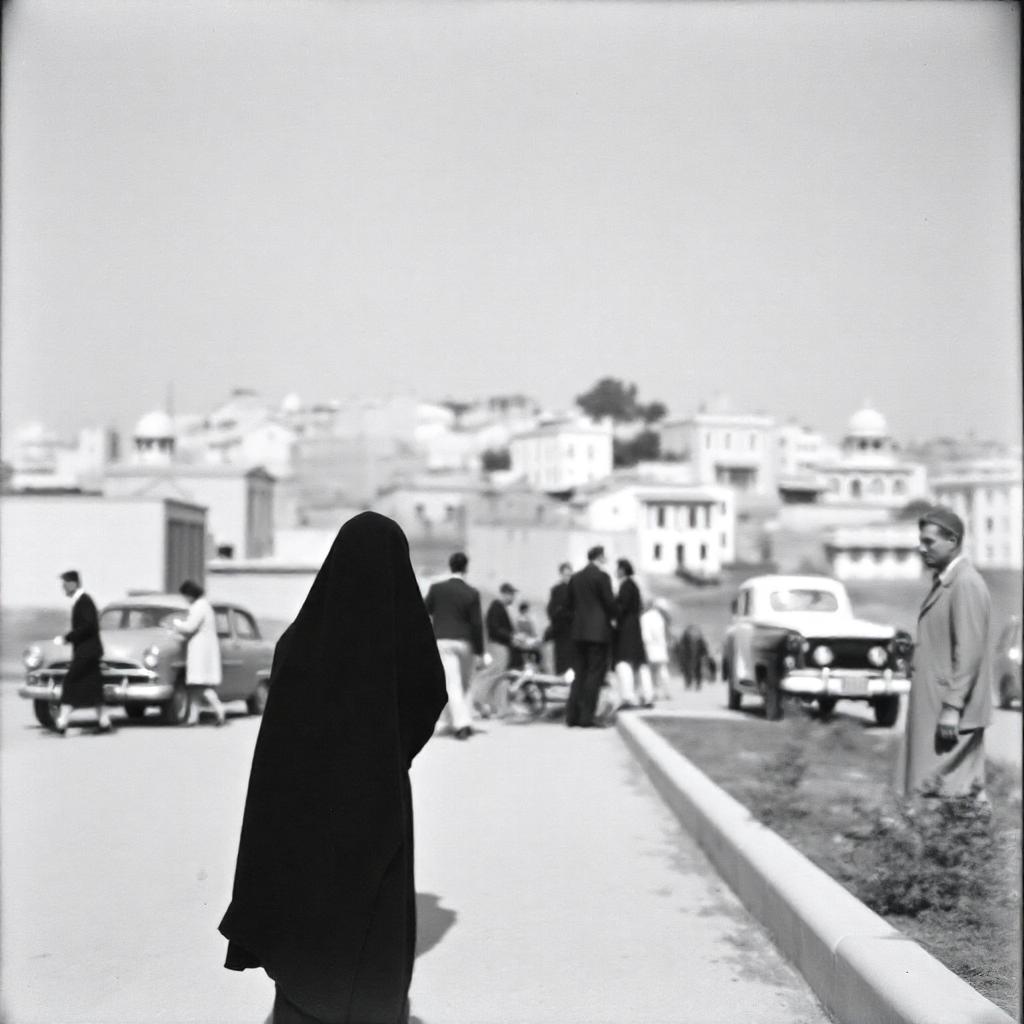
AI-generated image of a Muslim woman wearing a black chador, standing, lonely in the Haifa of the 1920s with cars in the background as a visual reference to her awful journey from Iran. AI illustration generated by Pikaso AI.
This is the story of the enduring influence of the Greatest Holy Leaf’s love on all those who came to the Holy Land, pilgrims and even those who were not Bahá'í. The love she poured out on everyone alike purified their hearts and uplifted their souls, and sometimes, as in the case of this story, stayed with them for the rest of their earthly life.
A Persian Bahá'í and his Muslim wife, along with other Bahá'í pilgrims drove by car from Persia, crossing the scorching Syrian Desert between Baghdad and Damascus.
The journey was so difficult that some of the travelers got impatient and were rude with the Muslim woman, who was hurt but said nothing.
After a hot and harrowing journey, they finally arrived at the Master’s house in Haifa, where they found the Greatest Holy Leaf, waiting, expectantly, outside the door.
The newly-arrived Bahá'í pilgrims rushed to meet her. Bahíyyih Khánum greeted them, but still stood outside, waiting.
Who could the Greatest Holy Leaf possibly be waiting for?
Eventually, they saw the Muslim woman walking slowly, filled with concern and uncertainty. The Greatest Holy Leaf went towards her and took her into her arms, held her by the hand, and led her into the women’s room where she invited her to sit by her side. Bahíyyih Khánum took off her own ring and placed it on the woman’s finger.
This woman, who was not a Bahá'í, was the Greatest Holy Leaf’s guest of honor.
Everyone present was moved to tears by the Greatest Holy Leaf’s lesson on universal love and acceptance.
The woman never became a Bahá'í.
But many years later, on the day she died, the name on her lips was:
Bahíyyih Khánum.
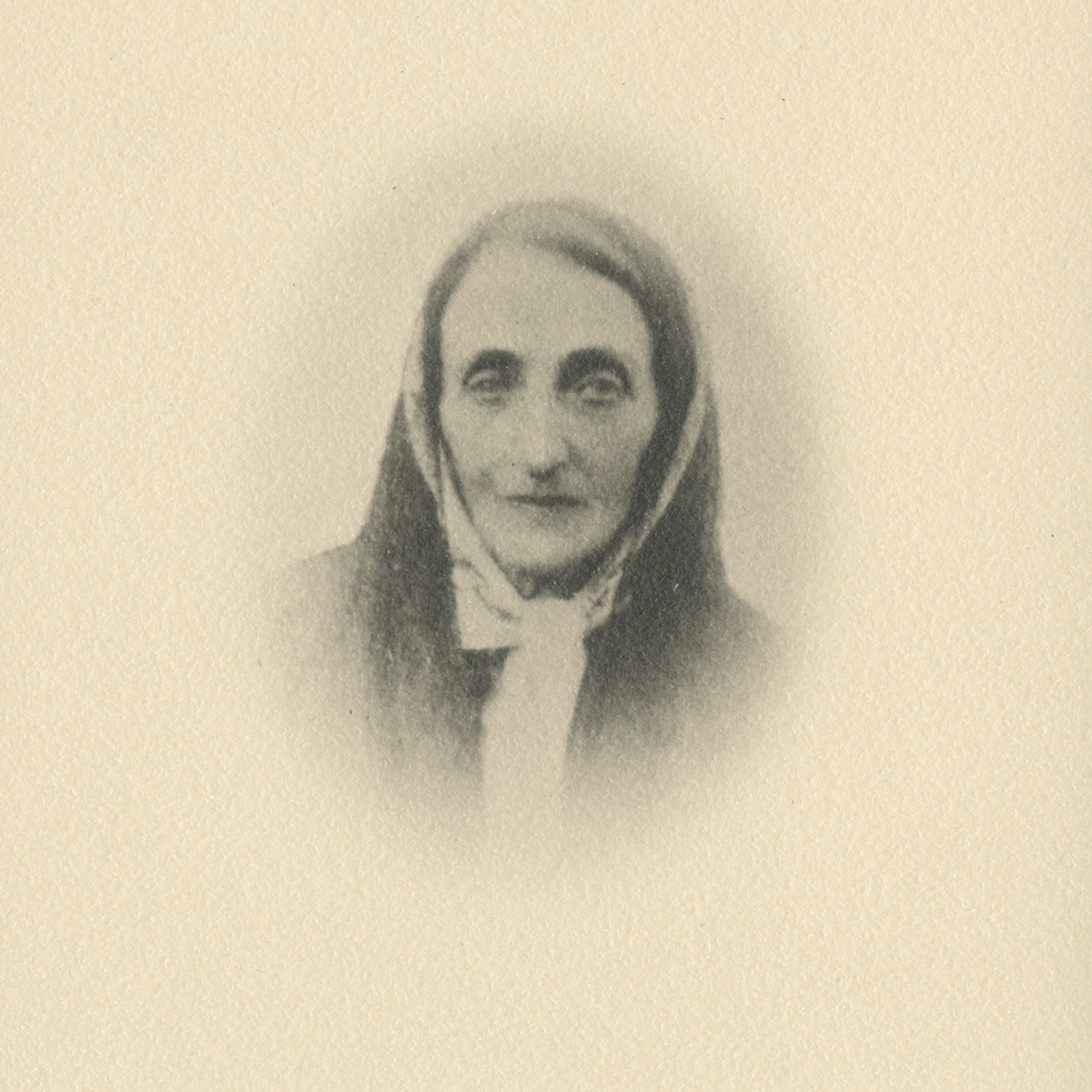
Original handwritten caption on the back of this photograph reads:
“The Greatest Holy Leaf. From Columbus Bahá'í Archives. Florence M. Rech.”© United States National Bahá'í Archives, used with permission.
In 1927, when Abu’l-Qásim Faizi, then 19, was a student at the American University in Beirut in Beirut Lebanon, he came on pilgrimage to Haifa. In fact, the students would come to the Holy Land every summer, if they could.
Abu’l-Qásim Faizi would, several decades later, be named a Hand of the Cause, and among his fellow students was Ḥasan Balyúzí—another future Hand of the Cause.
When the small group of students from Beirut was ushered into the presence of the Greatest Holy Leaf, she was sitting at the upper end of a large room, facing the door with Munírih Khánum, 'Abdu'l-Bahá’s wife, sitting next to her along with other women of the Holy Family. Standing behind Bahíyyih Khánum was Ḍíyá‘íyyih Khánum, the Guardian’s mother, her hands resting on her aunt’s shoulders.
The students sat facing the Greatest Holy Leaf. Although she was quite frail, the Greatest Holy Leaf made a strong impression on the young men, who sat across from her in awe at the fact they were gazing at the daughter of Bahá'u'lláh. They were too young to have ever met the Master in person but looking at His sister, they felt they were in His presence, because she so resembled Him, particularly her deep blue, penetrating eyes.
Abu’l-Qásim Faizi, in deep awe, described her majestic bearing:
Khánum sat still, her lily-white hands resting gently on her lap. She was a queen who inspired love and reverence, and at her throne of grandeur we offered our grateful hearts.
Munírih Khánum spoke on the Greatest Holy Leaf’s behalf, welcoming the pilgrims warmly and thanked them, at the end of their program of prayers, songs and Bahá'í poems.
The students were then served tea, and they left the Master’s house, utterly exhilarated with the joy of having brought an hour of pleasure to the Greatest Holy Leaf.
Later that evening, when they arrived at the Eastern Pilgrim House, they found out the Greatest Holy Leaf had sent them boxes of nuts and special sweets and realized how well-earned was Bahíyyih Khánum’s legendary generosity inherited from her sublime parents, Bahá'u'lláh and Ásíyih Khánum.
The Greatest Holy Leaf was famous for her generosity. She gave gifts to everyone who came to see her. One day, some Arab ladies had arrived at the house of the Master unannounced. The Greatest Holy Leaf went to her store of gifts to get them some presents and found it empty! So she gave the women the only thing she could think of: large handfuls of cube sugar!
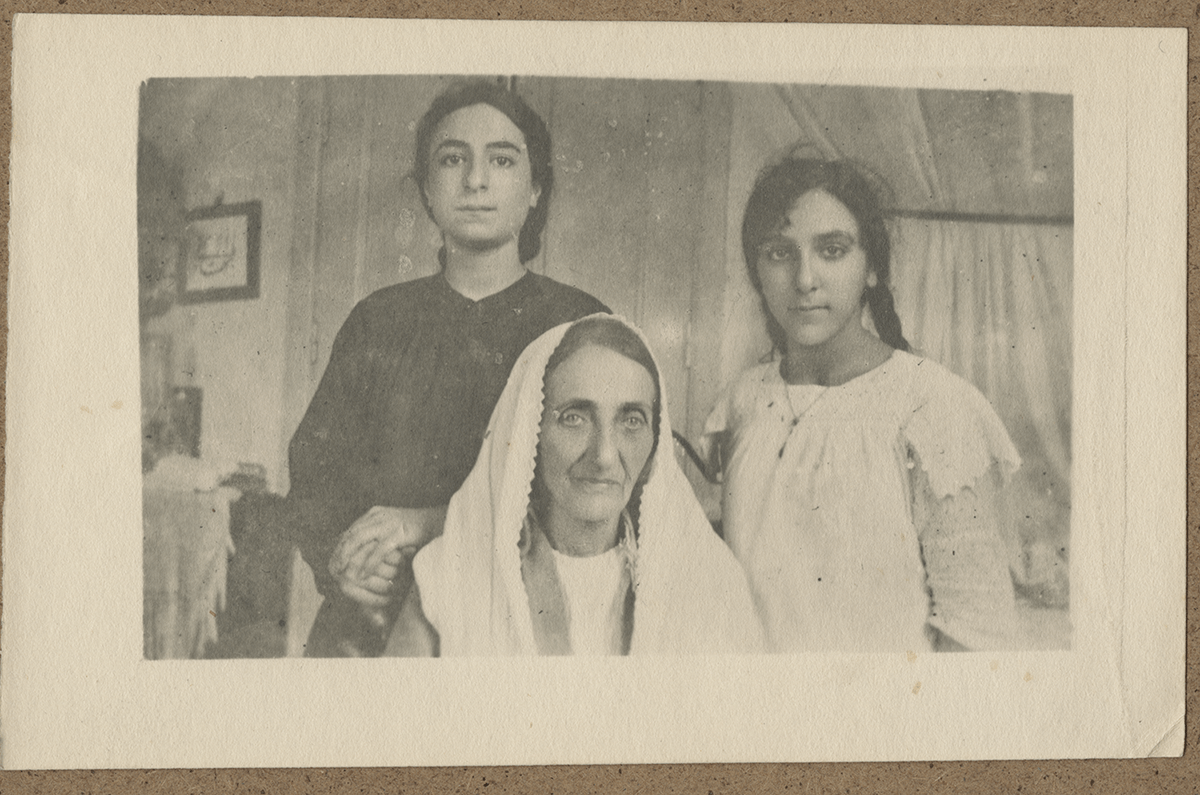
Photograph of the Greatest Holy Leaf with two young unidentified ladies. No information was provided on the back of the photograph. © United States National Bahá'í Archives, used with permission.
One day during Abu’l-Qásim Faizi’s pilgrimage, the Guardian turned to him and said:
Will you chant something?
Abu’l-Qásim Faizi was taken by surprised but luckily, he had a small collection of Tablets on him, and started to chant one of Bahá'u'lláh’s long achingly beautiful Tablets in which He teaches man to tread the path that leads to reunion with the Beloved.
Abu’l-Qásim Faizi chanted two pages, then stopped and whispered to the Guardian:
It is a very long Tablet.
The Guardian smiled and said:
Yes, it is one of the early Tablets revealed in Baghdad.
Then Shoghi Effendi turned to one of the elderly resident Bahá'ís and said:
Ḥájí Ḥusayn, it is a long time since you heard such chanting!
Then the Guardian turned back to Abu’l-Qásim Faizi and said to him:
You have a warm, resonant voice. Do you chant in your meetings in Beirut?
The very next day, a group of students of American University in Beirut were following the Guardian up Mount Carmel when Shoghi Effendi asked Abu’l-Qásim Faizi:
The Greatest Holy Leaf heard your chanting last night and would like to hear you again. Will you all go to her and make her happy?
Remembering the moment many years later, Abu’l-Qásim Faizi described how he felt when the Greatest Holy Leaf bestowed on him such an honor:
This rare, heavenly bounty was offered to us so suddenly that we could not immediately grasp its significance. But our joy was boundless and we spent more than half a day deciding on a suitable program of prayers, poems and songs which we could present to the daughter of Bahá'u'lláh.
The next afternoon, the young men from Beirut were again with the Guardian, walking towards the Shrine of the Báb when he turned to them and said:
Did you go to Khánum yesterday? Did you chant prayers and sing songs for her? Did she like them?
Abu’l-Qásim Faizi and his friends bowed and said yes, and the Guardian, with a smile, said:
I, too, had left the door of my room wide open.
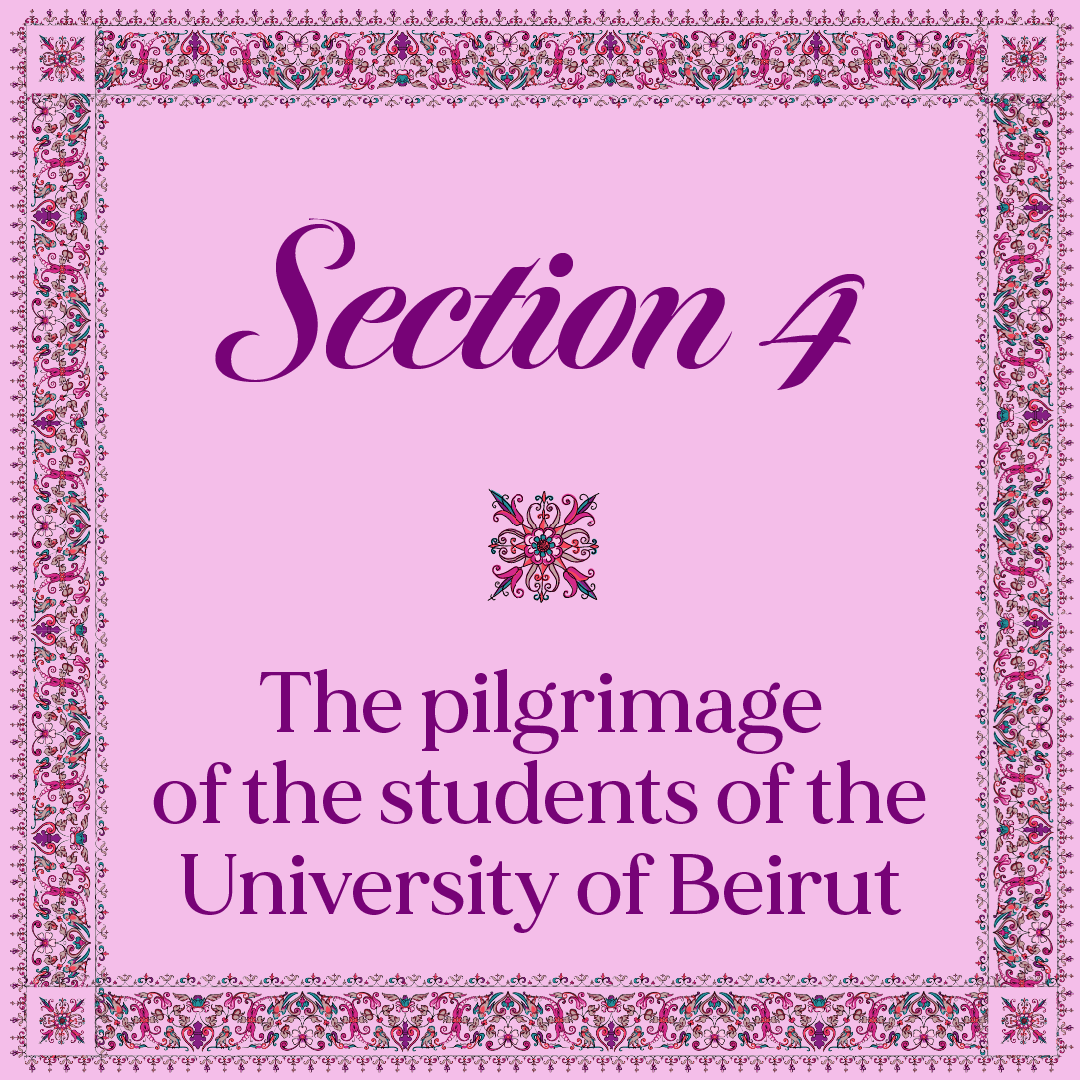
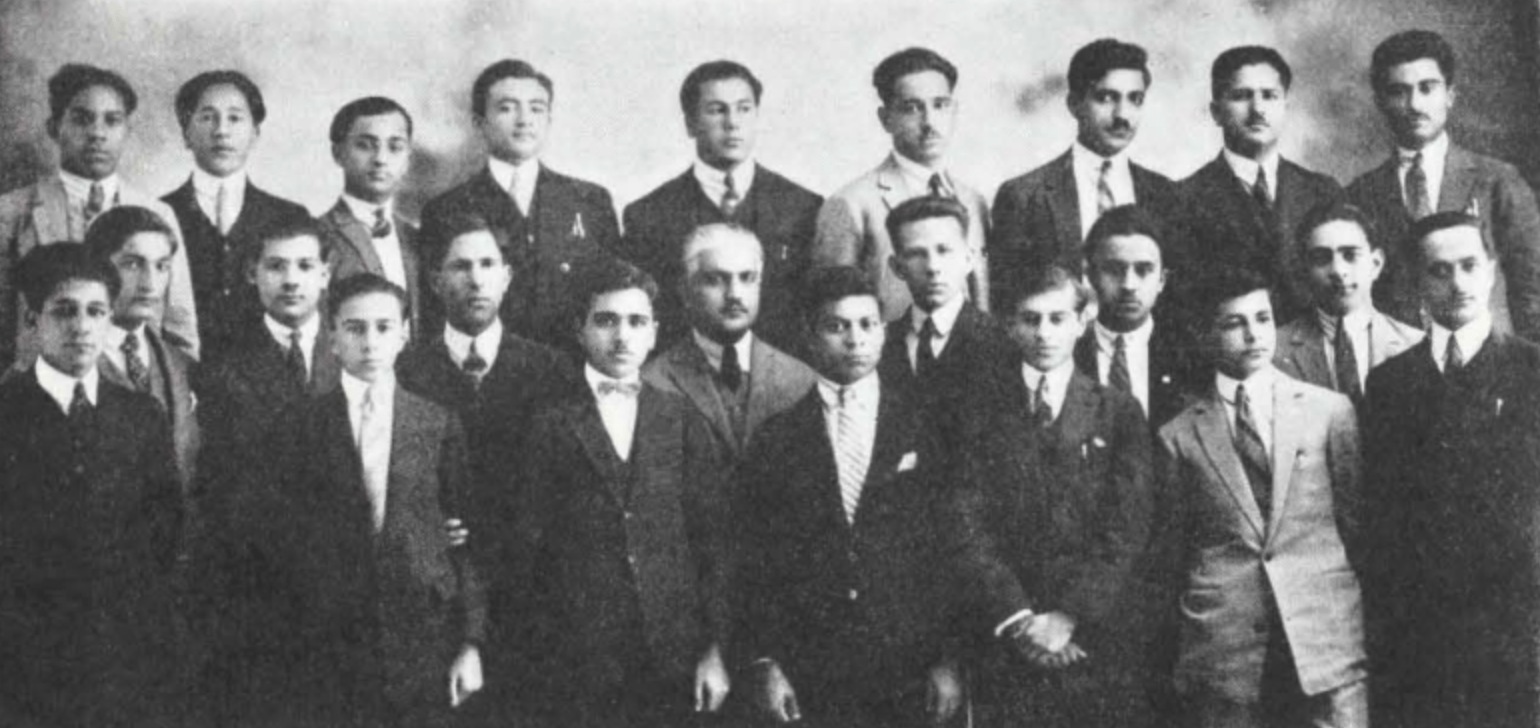
Bahá'í students at the American University in Beirut in 1927. Some of the youth in this photograph might have been present in 1928 at the performance their fellow student put on for the Greatest Holy Leaf. Source: Bahaimedia.
Abu’l-Qásim Faizi and Ḥasan Balyúzí and their friends from the American University in Beirut first came on pilgrimage in 1927, and Abu’l-Qásim Faizi in particular had deeply impressed both the Greatest Holy Leaf and the Guardian with the beautiful quality of his chanting, and still reeling from the feeling of their last visit, the next time they came, they came prepared. With a program.
I have placed this story symbolically in 1928, because Abu’l-Qásim Faizi does not give a date for this visit. The students from the American University in Beirut came during school vacations which take place in the summer, around Christmas and Easter.
The students had prepared a one-act play called “The Light of Faith in the Darkness of the Dungeon” about the sufferings of the martyrs in Persia. When they asked the Guardian if they could perform it in the house of the Master, Shoghi Effendi, out of immense empathy for the sensitivity of his great-aunt said:
No, it would sadden the heart of the Greatest Holy Leaf.
But the Guardian was so kind and generous, he did allow the Beirut students to come to the house of the Master once again as they had the last time they had visited and entertain the Greatest Holy Leaf with songs and poems.
But he allowed us to go to the Master's house once more and entertain the Greatest Holy Leaf with songs and poems.
The very clever young men of the University of Beirut had prepared extensively for this very thing.
One could even say that they planned everything perfectly.
One of their fellow students had learned how to play the tár with a great master in Persia.
The tár, invented in Shíráz, gets its name from the Persian word for “string.” It is a very striking stringed instrument with an incredibly long neck, and it is plucked very close to the chest. The plaintive, very distinctive sound it makes is perhaps the most Persian sound that exists in the world, strong and clear soft and gentle, and deeply emotional and evocative.
The young man had been uncomfortable and reluctant with the idea of bringing his tár on pilgrimage to the Holy Land, saying it wasn’t the proper thing to do.
His friends absolutely begged him to.
They knew, they just KNEW the Greatest Holy Leaf would love it.
On top of that, the young man was absolutely phenomenal at the tár, and had been gifted with light fingers and a very lovely touch.
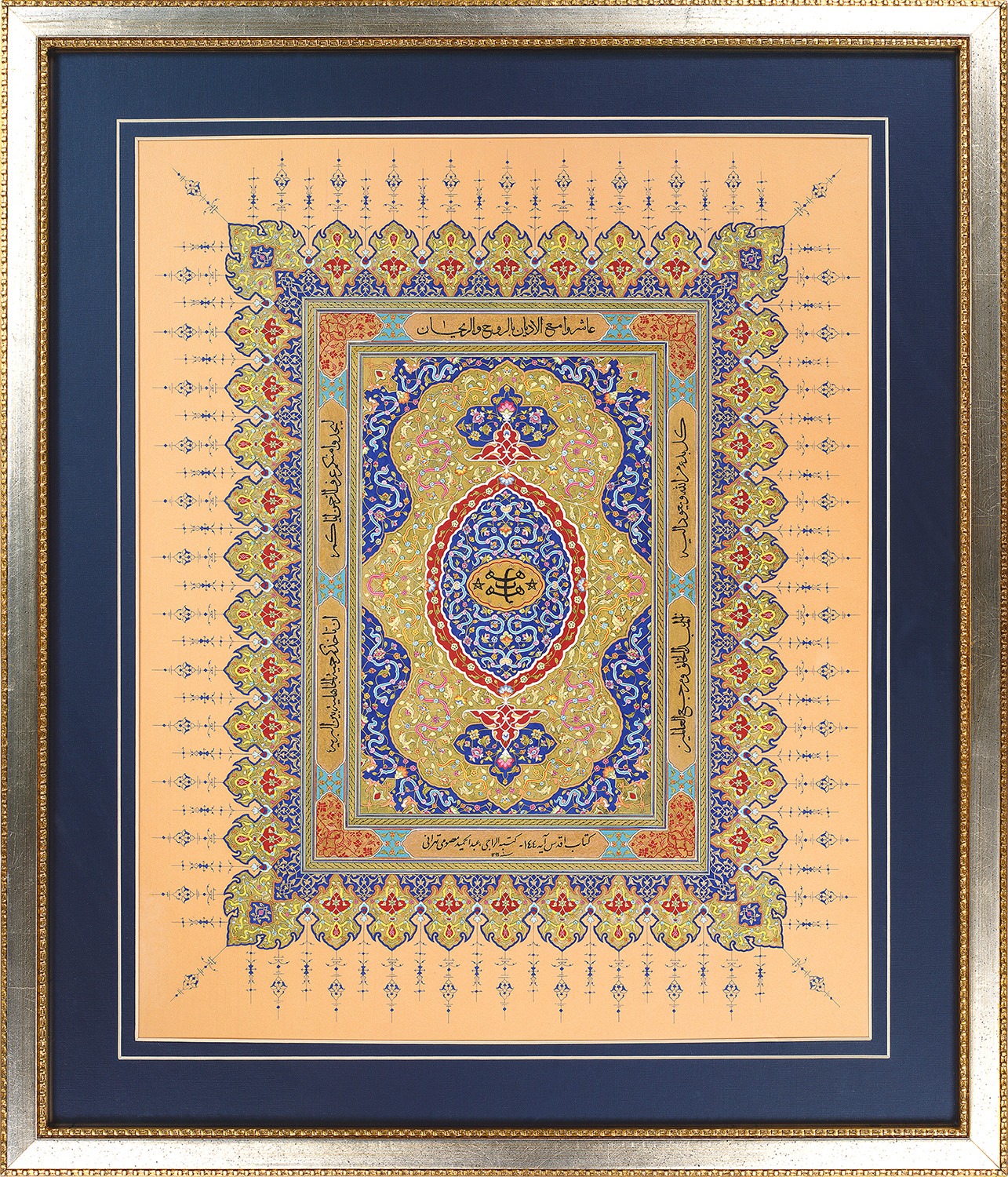
As an abstract illustration of a story where Abu’l-Qásim Faizi is feverishly calligraphing and Tablet for the Greatest Holy Leaf, this is an illuminated calligraphic work by Ayatollah Abdol-Hamid Masoumi-Tehrani, containing the words of Baha'u'llah. Source: Bahá'í World News Service.
The Greatest Holy Leaf absolute loved the program the young men from the American University in Beirut had prepared.
One of the simple but deeply moving songs they sang included the refrain:
O 'Abdu'l-Bahá, my hand is stretched out in longing to reach Thy robe.
Abu’l-Qásim Faizi chanted a Tablet revealed by 'Abdu'l-Bahá in honor of a Bahá'í who had greatly suffered in the path of Bahá'u'lláh. In this Tablet, 'Abdu'l-Bahá recounts all the blessings Bahá'u'lláh has bestowed upon us in the Faith and asks at the end of each verse the question:
Why, then, should we be sad?
When Abu’l-Qásim Faizi finished chanting the Tablet, the Greatest Holy Leaf asked to have a copy of it. Later that night in the Eastern Pilgrim House, Faizi would spend hours choosing the perfect paper and the perfect pen with which to copy the Tablet, and he made copy after copy after copy until he was finally pleased enough with the result to offer it to his beloved “Khánum.”
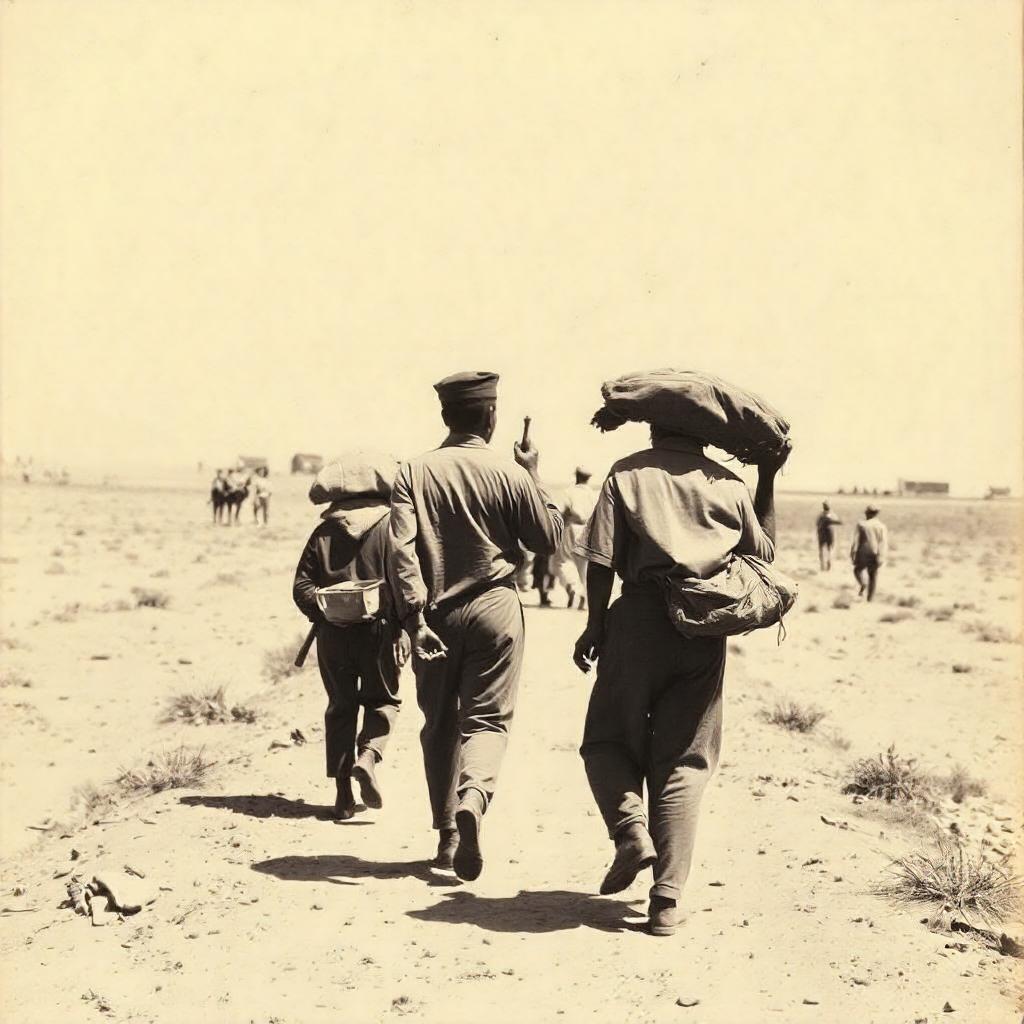
AI-generated image of 19th century Persian laborers in the countryside returning home after a day of work. AI illustration generated by Pikaso AI.
At the end of the students’ program, Munírih Khánum spoke to them on behalf of the Greatest Holy Leaf.
Bahíyyih Khánum had left Persia when she was 6 years old, nearly 8 decades before, but she had held onto a very dear memory from her brief time in Ṭihrán: in the evenings after they had finished their work, manual laborers would sing a certain song on their way home. These types of songs are known as kúchih-baghí, sad, penetrating songs that fill the heart with deep emotion.
Munírih Khánum said the Greatest Holy Leaf wanted to know if anyone present knew this type of song.
One of the students with a beautiful, penetrating voice began to sing for the Greatest Holy Leaf.
The students wondered whether it had been the plaintive sound of the tár which had prompted made such a deep, ancient memory resurface in the mind of the Greatest Holy Leaf, but they were so moved by the laborers’ song that they felt inversely carried into Bahíyyih Khánum’s memories of exile and imprisonment and her times of great sorrow and imprisonment in the company of those she loved.
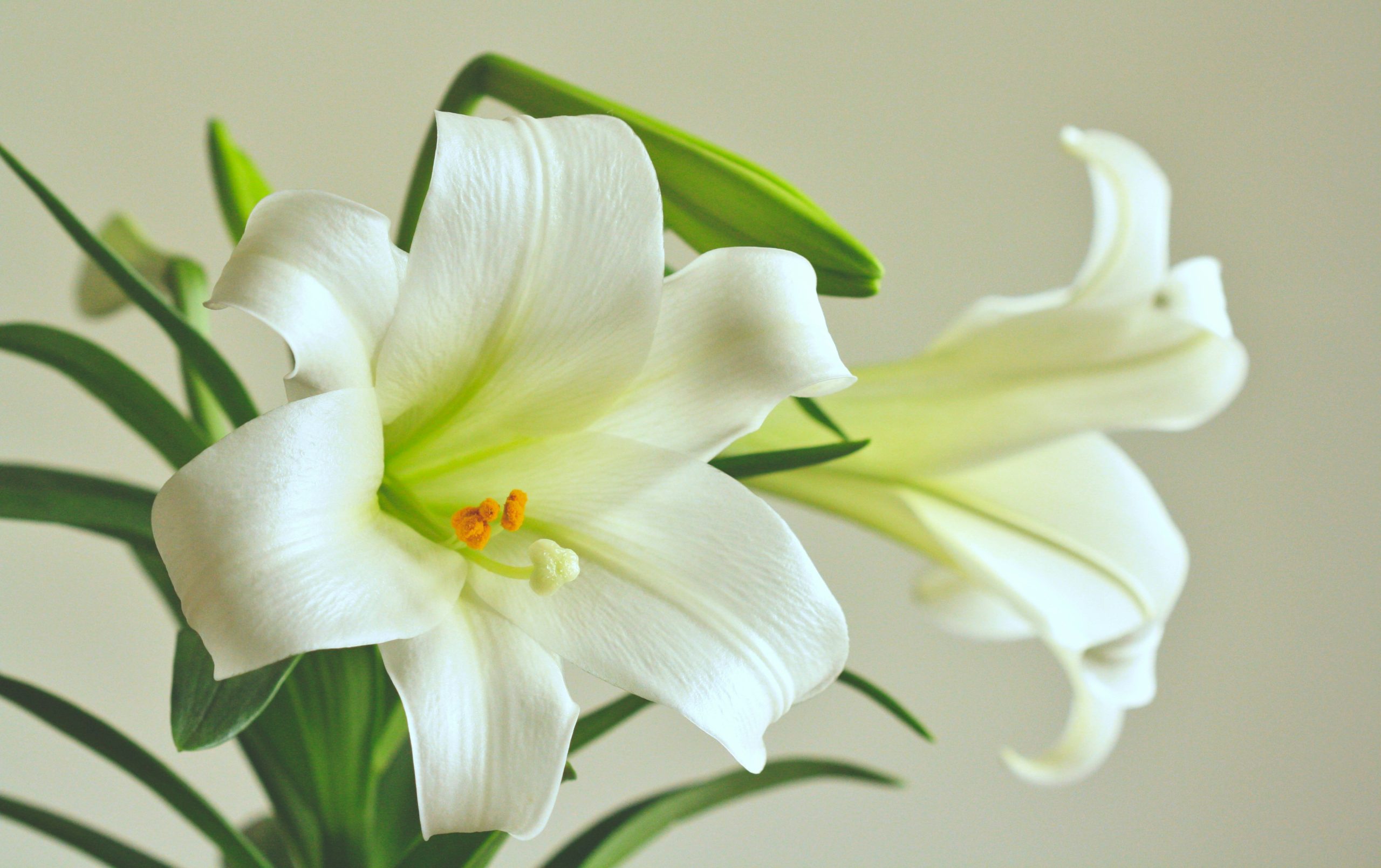
Photo by Ashlee Marie on Unsplash.
By this time in the program, the sun had set and the light in the room had faded.
Through the tears in his eyes, all Abu’l-Qásim Faizi could see was the Greatest Holy Leaf’s white scarf and her soft white hands on her lap. Seeing the hands of Bahíyyih Khánum had a profound spiritual effect on Faizi:
They appeared to me as the wings of a white bird flying over the dark city of 'Akká, bringing the message of strength and courage. I saw Khánum’s hands removing the chains placed around her Father's neck, and drying her mother's tears when the Purest Branch was dying. And again I beheld them raised in prayer when she heard the lamentations of Bahá'u'lláh in His cell the night He had offered His beloved son as a sacrifice in the path of God: “Mihdí! Mihdí”! Had it not been for all those bitter tests, these hands, as white as a lily, as strong as the grip of destiny, would not have been able to hold the reins of the affairs of the Bahá'ís around the world for almost two years when 'Abdu'l-Bahá had passed away and the Guardian was absent from the Holy Land.
Abu’l-Qásim Faizi bowed his head in gratitude to the saintly daughter of Bahá'u'lláh.
It was the last time he would ever see her.
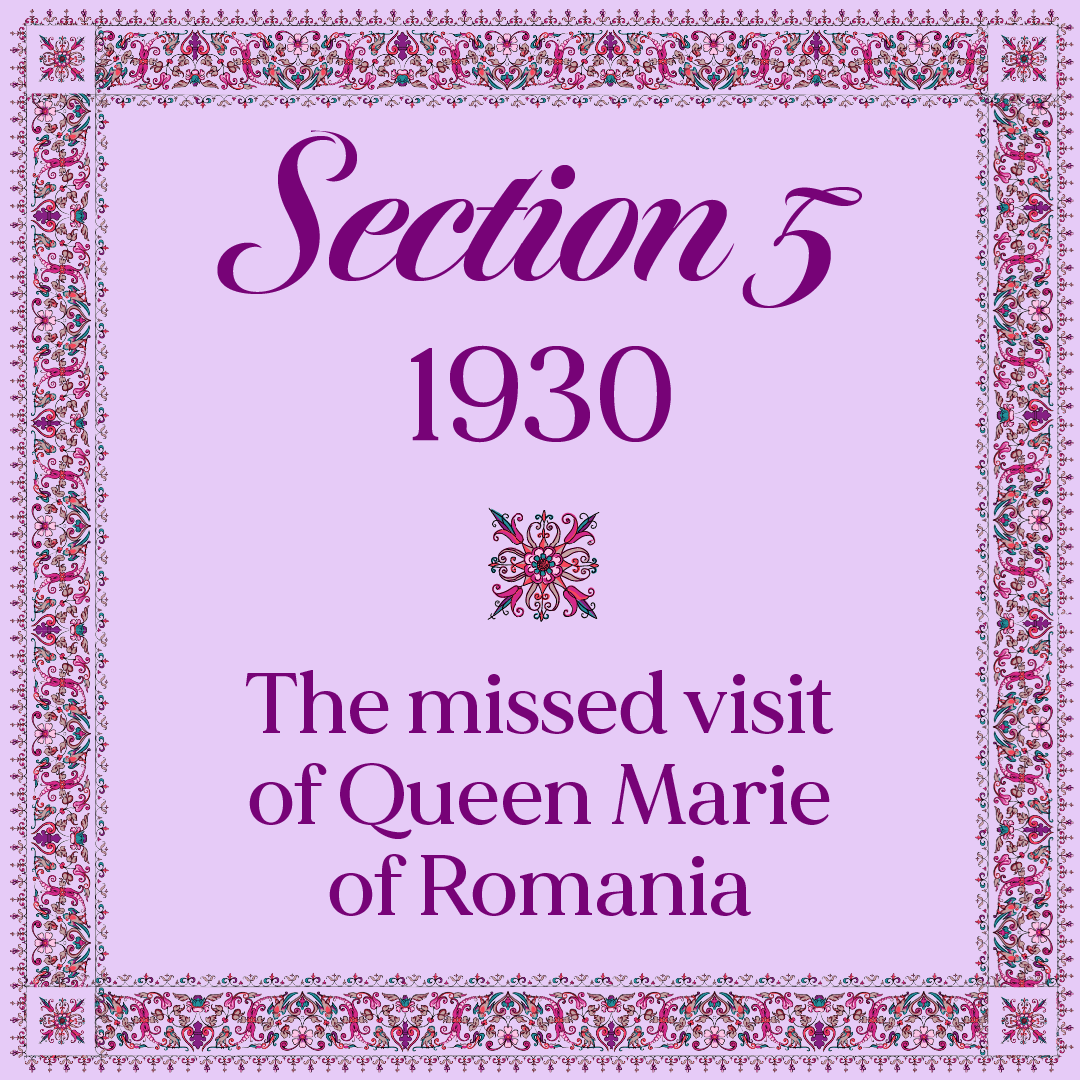
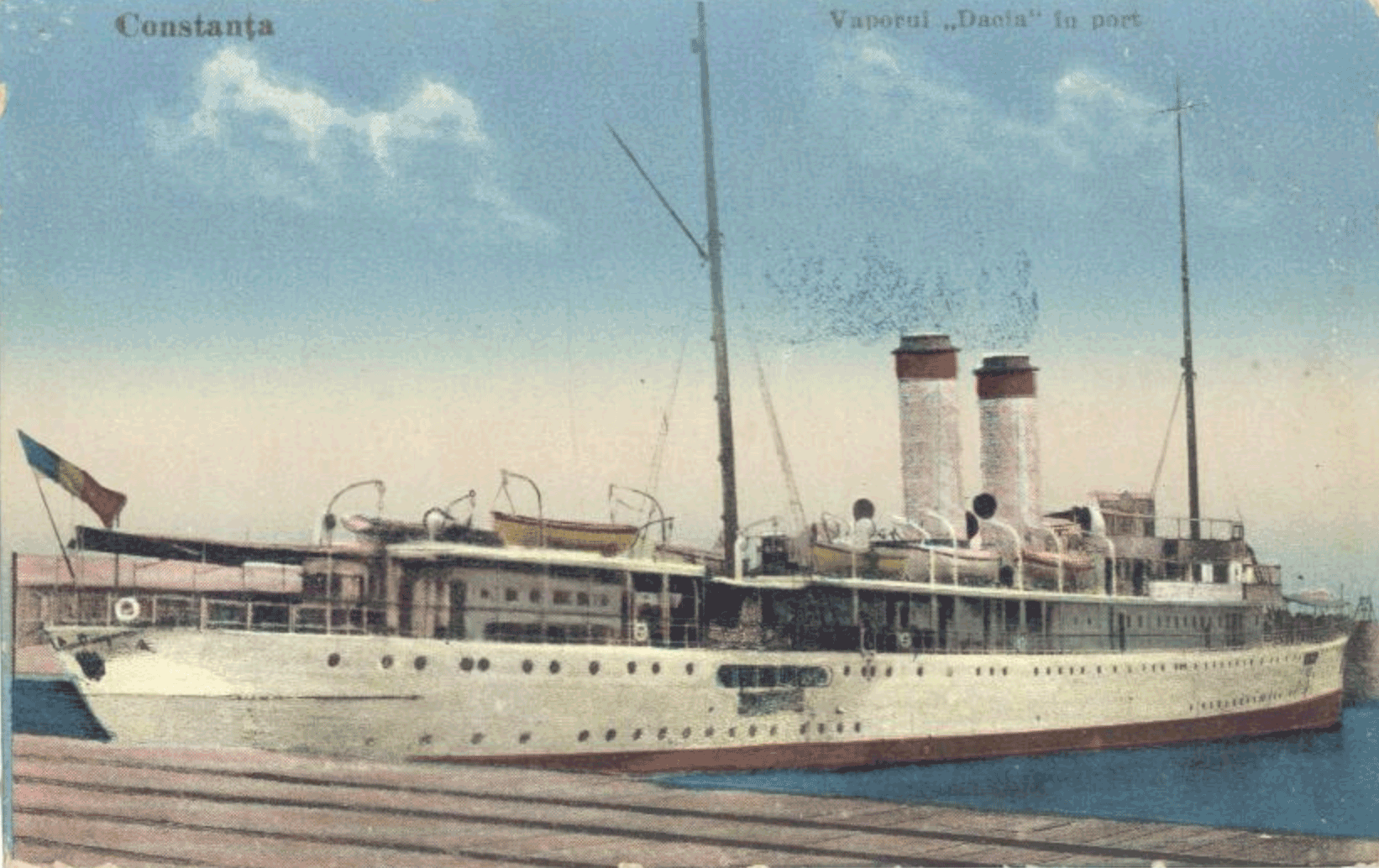
The Dacia, the Imperial Yacht aboard which Queen Marie of Romania sailed to Egypt and to the Holy Land, but was unable to visit Shoghi Effendi and the Greatest Holy Leaf. Source: Wikimedia Commons.
Queen Marie of Romania had been introduced to the Bahá'í Faith by Martha Root in 1926. Queen Marie was planning a visit to Egypt and the Middle East in 1930, and she had told Martha Root very decisively:
We shall surely go to Haifa.
Queen Marie of Romania and her daughter Ileana left Romania on the royal yacht, the Dacia, and traveled from Istanbul to Athens, arriving in Alexandria sometime in February 1930.
Both Shoghi Effendi and Bahíyyih Khánum were anxiously awaiting Queen Marie’s visit in March 1930, and Shoghi Effendi began making preparations. He wired the Bahá'ís in Egypt and asked them to only convey written expressions of welcome on behalf of the Bahá'ís and to avoid individual communications.
The Guardian also prepared a priceless gift. He asked the Bahá'ís of Persia to reproduce Bahá'u'lláh’s Tablet to Queen Victoria, Queen Marie’s grandmother in the finest calligraphy, illuminate the Tablet and send it to the Holy Land no later than 10 March 1930.
Everyone was heartbroken at the missed visit of Queen Marie: Queen Marie, Shoghi Effendi, the Greatest Holy Leaf, and the entire Holy Family.
On 30 March 1930, Queen Marie’s ship docked in Haifa. The Greatest Holy Leaf had waited, hour after hour, in the Master's home to receive Queen Marie and Princess Ileana, and even Shoghi Effendi had hoped the visit and the Queen’s pilgrimage would take place.
Time passed and no news came.
In her diary, Queen Marie sheds light on what happened. She had docked in Haifa in the early morning of 20 March. Then, the party had been met at the ship, informed her visit was politically impossible, the Queen was placed in a car and driven to Syria.
Queen Marie was just as heart-broken as Shoghi Effendi and the Greatest Holy Leaf that her visit to Haifa and 'Akká did not take place. Shoghi Effendi describe “the keen disappointment of the aged Greatest Holy Leaf who had eagerly expected.”
One year later, on 28 June 1931, she wrote to Shoghi Effendi and expressed her feelings about the missed visit:
Both Ileana and I were cruelly disappointed at having been prevented going to the holy shrines and of meeting Shoghi Effendi, but at that time were going through a cruel crisis and every movement I made was being turned against me and being politically exploited in an unkind way. It caused me a good deal of suffering and curtailed my liberty most unkindly.

Pelișor Castle in Sinaia, Romania, where Queen Marie of Romania summoned Martha Root in October 1927 after which Martha Root requested four rings from the Greatest Holy Leaf. Source: Wikimedia Commons.
The Greatest Holy Leaf did not have a direct relationship with Queen Marie of Romania, but she is so frequently mentioned in the letters to and from Shoghi Effendi and Martha Root about Queen Marie, that this section aims to show how much she appreciated the Queen and how reciprocal that respect and love was on the part of the Queen.
On 9 October 1927 Queen Marie summoned Martha Root to Pelisor Castle in Sinaia. In her letter to Shoghi Effendi she mentioned Queen Marie and Princess Ileana sent them their greetings, then asks for a favor from the Greatest Holy Leaf. Martha Root wondered if it would be possible for Bahíyyih Khánum to send four stones to her for Queen Marie, Princess Ileana, one of the princes and his officer.
A reference to Bahíyyih Khánum can be found in a letter from Shoghi Effendi to Martha Root dated 30 December 1927, where he states:
…the Greatest Holy Leaf…has learned to love you, to admire you, and to appreciate to the full the significance of your work for the Cause.
On 21 January 1928, Martha Root visited Queen Marie and Princess Ileana, and they both asked about the Greatest Holy Leaf, Munírih Khánum and the progress of the Faith.
On 3 December 1929, Shoghi Effendi wrote a letter to Queen Marie acknowledging the autographed portrait she had sent to him via Martha Root and assured the Queen of the Greatest Holy Leaf’s as well as the Holy Family’s gratitude for the gift.
On 31 January 1933, six months after the Greatest Holy Leaf’s passing, Martha Root met again with Queen Marie. When they were talking about hyacinths, Martha Root mentioned to the Queen how lovely the Greatest Holy Leaf always looked, and the Queen asked her to keep speaking about her, and her interest deeply touched Martha Root who mentioned it to the Guardian in her letter. After some time, Queen Marie said:
There are people who just radiate good. It is like a clear atmosphere, they do not realize the good they do.
On 1 March 1934, Martha Root mentioned to Shoghi Effendi that she gave her own large photograph of the monument of the Greatest Holy Leaf to Queen Marie. During this visit, Queen Marie once again not only spoke herself about the Greatest Holy Leaf, but asked Martha Root to tell her more stories about Bahíyyih Khánum.
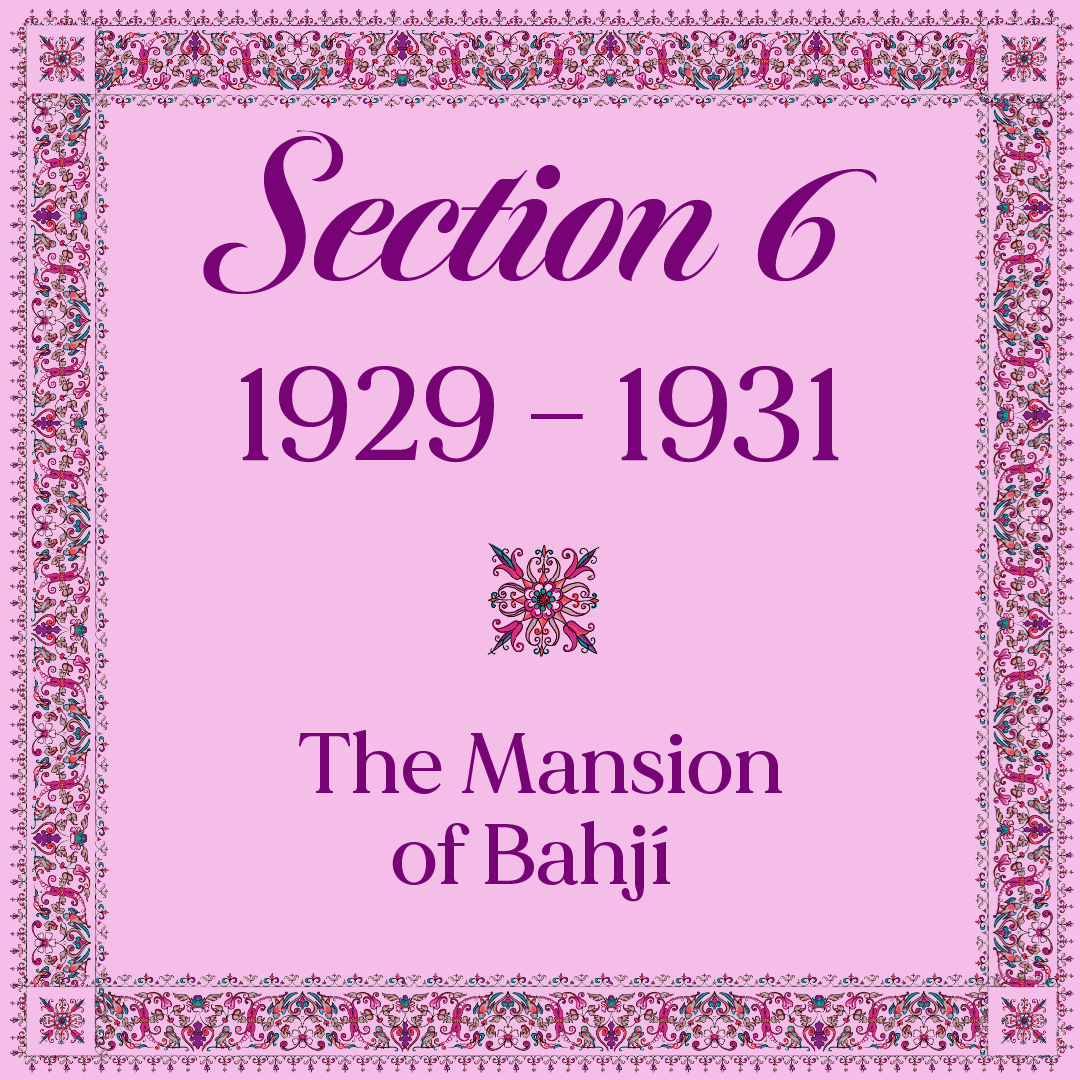
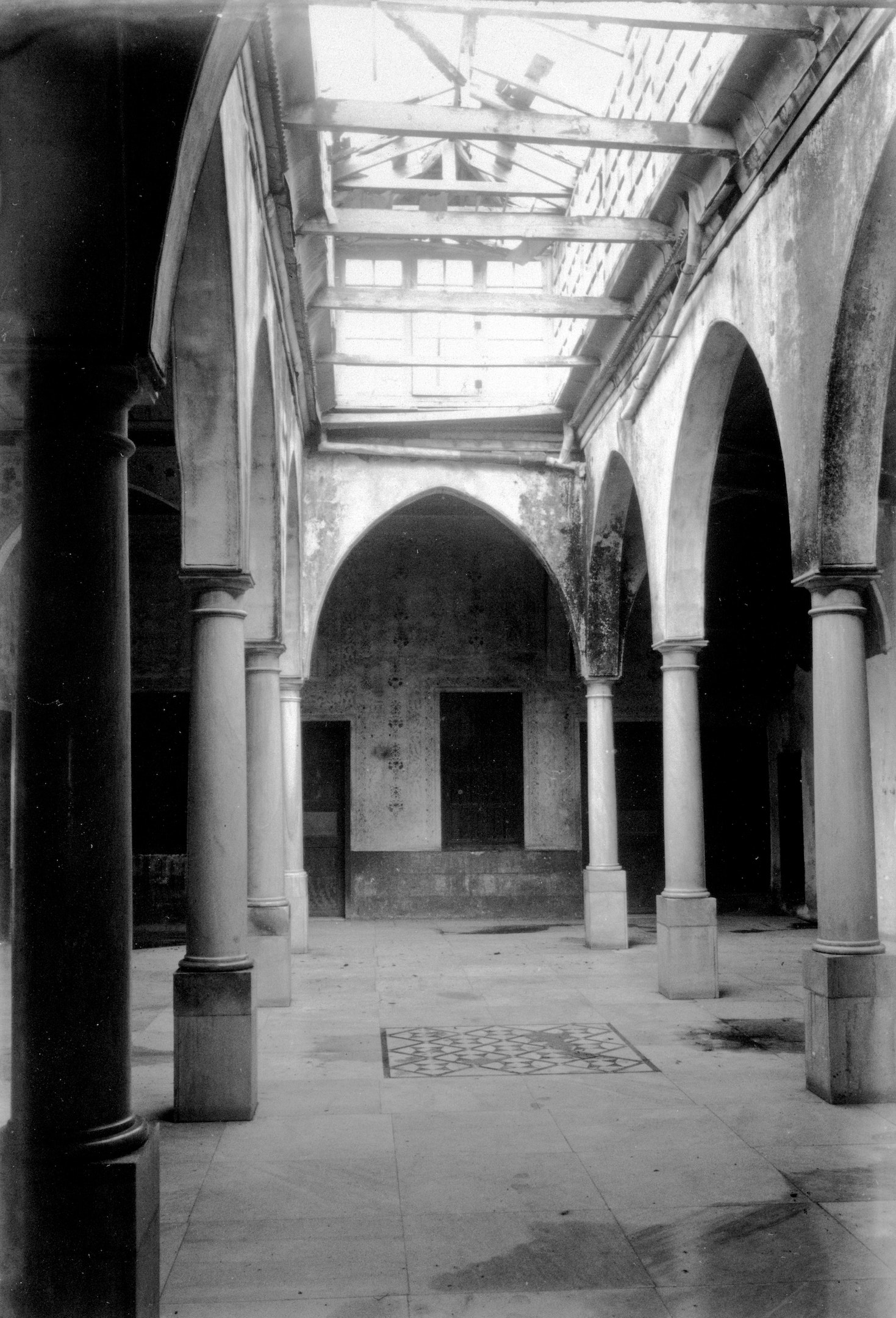
The main hall of the Mansion of Bahjí just before the Guardian began its restoration in 1929. Source: Bahá'í Media Bank, © Bahá'í International Community 2023.
After Bahá’u’lláh’s Ascension, Covenant-breakers occupied the Mansion of Bahjí: first, Bahá'u'lláh’s second wife, Fáṭimih Khánum and her children, then Mírzá Muḥammad-'Alí moved in.
Then, they stayed.
For nearly 40 years, the Greatest Holy Leaf never set foot in the Mansion, her Blessed Father’s final earthly home, and the place where He passed away. The Covenant-breakers had neglected the Mansion so badly that by 1929, it was falling into ruin: the roof was caving in and the building needed major repairs were unwilling to undertake.
Shoghi Effendi sent a message to Mírzá Muḥammad-'Alí, the arch-breaker of the Covenant of Bahá'u'lláh, saying:
I am going to repair the Mansion and am waiting for you to vacate it. If you do not vacate it voluntarily, I will appeal to the authorities to evict you.
Finally, on 27 November 1929 Yadu’lláh Tabrízí—who served in the Holy Land for 40 years—delivered the keys of the Mansion of Bahjí to the Greatest Holy Leaf in Haifa while Shoghi Effendi was away in Switzerland.
Bahíyyih Khánum was overjoyed.
The Mansion of Bahjí was finally back in the hands of the Faith, freed of the Covenant-breakers, but it was in ruins.
The gardens were destroyed. All the trees were thirsting for water, on the verge of death, the fabulous orange and tangerine trees had withered.
Shoghi Effendi was away from Haifa when finally handed the Greatest Holy Leaf the keys to the Mansion.
The first thing Bahíyyih Khánum told Yadu’lláh was:
Do water the trees well so that they will become verdant by the time [Shoghi Effendi] returns.

Chosen Highway, the book written by Lady Blomfield chronicling the lives of the Greatest Holy Leaf and other member of the Holy Family. Source: George Ronald.
When Lady Blomfield arrived for her second pilgrimage in 1930, she interviewed the Greatest Holy Leaf, Munírih Khánum—the widow of 'Abdu'l-Bahá—Túbá Khánum—a daughter of 'Abdu'l-Bahá—Mirza Asadu'llah Kashani, Sakinih-Sulṭán Khánum, Siyyid 'Ali Yazdí and others.
The book would later be published under the title The Chosen Highway.
The Greatest Holy Leaf was recounting the perils of the Holy Family’s harsh winter ordeal in January – April 1853 to Lady Blomfield when she noticed tears in her listener’s eyes. Bahíyyih Khánum said:
This time is very sad, Lady, I shall make you grieve if I tell of it.
Lady Blomfield replied:
Oh, I want to be with you in my heart through all your sadness, dearest Khánum.
The Greatest Holy Leaf replied:
Well, well! If I did not live in my thoughts all through the events of the sad days of our lives, I should have naught else in my life, for it has been all sorrow; but sorrow is really joy, when suffered in the path of God!
Lady Blomfield’s book The Chosen Highway is a treasure for Bahá'í history. It is the closest we come to a biography of the Greatest Holy Leaf, recounted directly from her memories, and rich in details about her early life from her birth, stories about her parents and siblings, her witnessing the most momentous events of the history of the Faith in the 19th century, her four exiles and her life in the Most Great Prison and 'Akká.
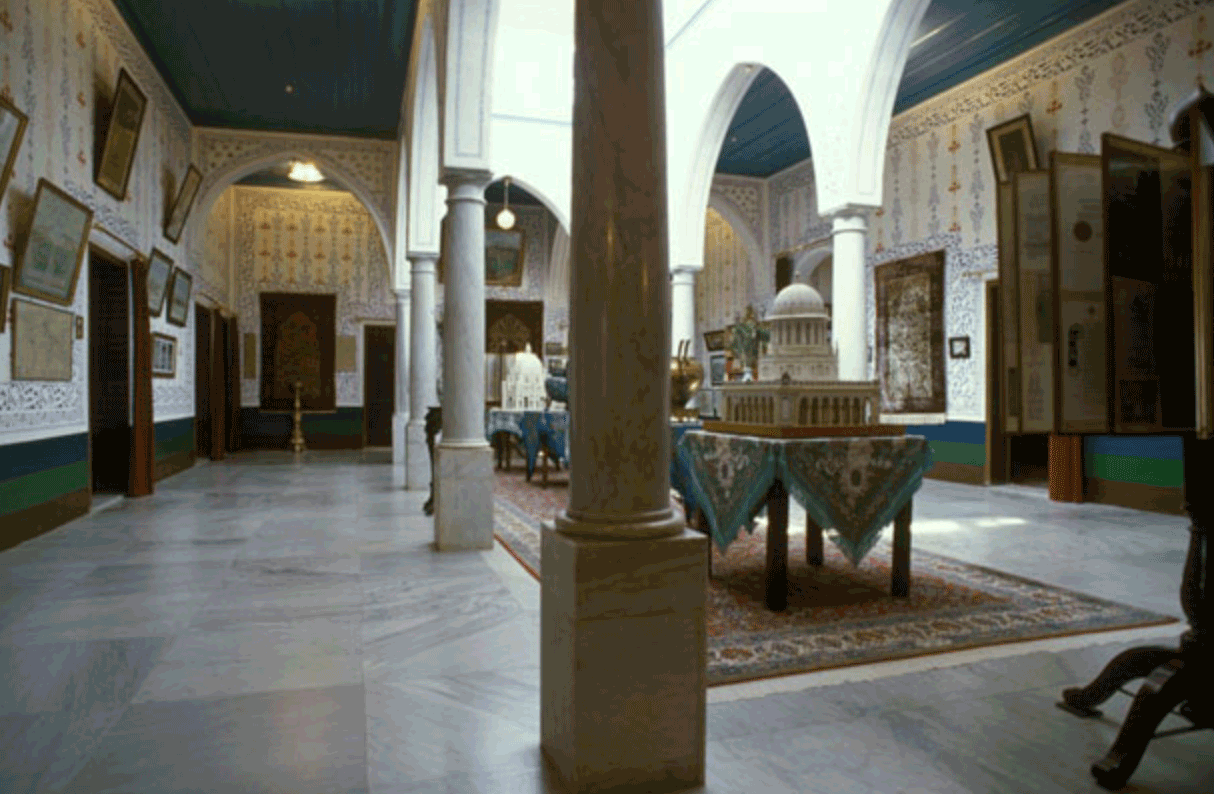
The Central Hall of the upper floor of the Mansion of Bahjí, entirely decorated by Shoghi Effendi. Source: Bahaimedia.
Shoghi Effendi had found the Mansion of Bahjí in a state of utter ruin. Everything had been stripped, the gardens were dying, and the mansion was falling apart.
Once his 18-month restoration of the Mansion was complete, the Guardian arranged an elaborate surprise for the Greatest Holy Leaf to come and see how it had been furnished and decorated.
The last time the Greatest Holy Leaf had set foot in the Mansion of Bahjí was shortly after the Ascension of Bahá'u'lláh, 39 years before.
The Guardian wanted Bahíyyih Khánum to be the first person to see the renovated Mansion and spend time there.
A car brought the Greatest Holy Leaf to Bahjí with three people. When they arrived, the big southern entrance door was opened, and Bahíyyih Khánum stepped into the courtyard of the Mansion.
The Greatest Holy Leaf was 85 years old and too weak to climb the stairs, so a large chair was brought and Yadu’lláh Tabrízí and another Bahá'í carried her to the upper floor like a queen, placing the chair down in the central hall of the Mansion.
As soon as the Greatest Holy Leaf entered the hall, she exclaimed loudly, weeping and laughing simultaneously:
O Bahá’u’lláh! The Guardian of your Cause has repaired, furnished and decorated your blessed Mansion. O 'Abdu'l-Bahá! What a wonderful Guardian you have chosen for the Cause of God! He has restored the glory of the blessed Mansion.
The Greatest Holy Leaf asked to see Bahá'u'lláh’s bedroom, the room in which her Father had passed away.
The Greatest Holy Leaf had thought of brining boxes of baklava—a very sweet, nutty, layered pastry dessert popular in the Middle East—for the Bahá'ís that day and the visitors, Bahá'í and non-Bahá'í who were coming to the Mansion the following day.
Bahíyyih Khánum spent six very happy days around the Mansion of Bahjí and the Shrine of Bahá'u'lláh.
She spent one night in the Mansion and the other five in the pilgrim house.
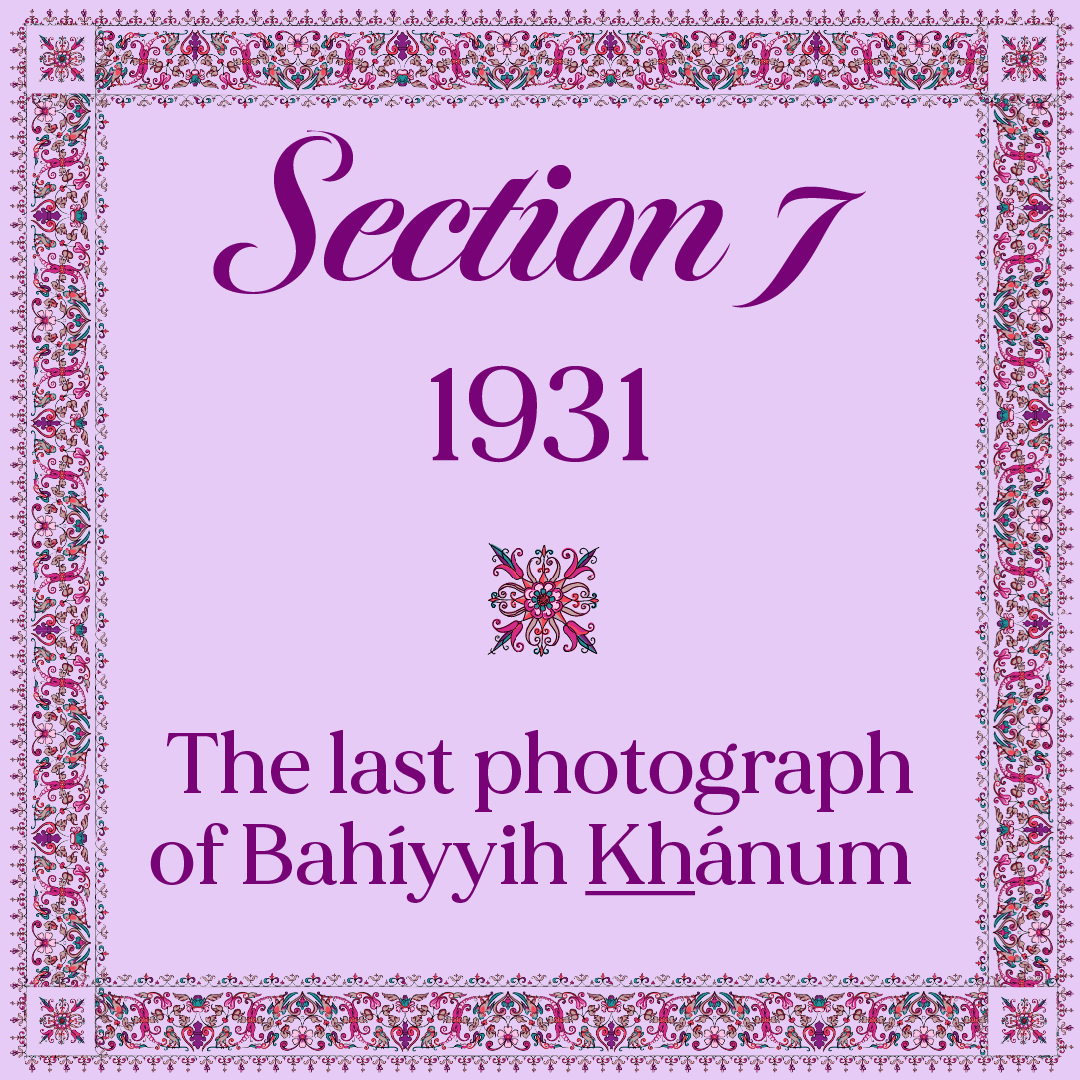

This is the last photograph ever taken of the Greatest Holy Leaf by Effie Baker. It was first published in The Bahá'í World Volume 5 (1932-1934) on page 170. This extraordinary quality print in color, where you can see the blue eyes of the Greatest Holy Leaf and light blue on the scarf around her neck is courtesy of the United States National Bahá'í Archives.
Euphemia “Effie” Baker, the second Australian Bahá'í and a professional photographer. She had been the hostess of the Western Pilgrim House and had taken thousands of photographs which Shoghi Effendi had used to illustrate The Dawn-Breakers.
One day in 1931, Effie Baker was taking a very special photograph: her assignment was to capture one of the most sacred relics in the Faith, the painting of the Báb done in Urúmíyyih when He was 29 years old, and which was in Bahíyyih Khánum’s room. Effie had asked Saichiro Fujita to help her with the delicate task.
As Bahíyyih Khánum was in the room with them, Effie asked her two or three times if she would allow her to take her portrait. The Greatest Holy Leaf declined, and Effie decided not to press her.
The Greatest Holy Leaf was sitting on the side of her bed, and watching Effie work with great interest.
Encouraged by this, Effie followed her instinct and asked the Greatest Holy Leaf one last time if she could take her portrait, because she had only one photographic glass plate left.
The Greatest Holy Leaf said yes!
Effie quickly refocused her camera, and as she took the picture, Saichiro Fujita spoke to her and the Greatest Holy Leaf said, smiling:
What did you say Fujita?
And that was how Effie Baker took the very last photograph of the Greatest Holy Leaf, one year before her passing.
This photo of the Greatest Holy Leaf was first published in The Bahá'í World Volume 5 (1932-1934) on page 170. Speaking of her portrait, Effie would later say:
To me it is Khánum as I knew her. Some people say how thin and frail her hands showing the veins but I just love them for I knew the soft loving caressing touch of those lovely fingers.
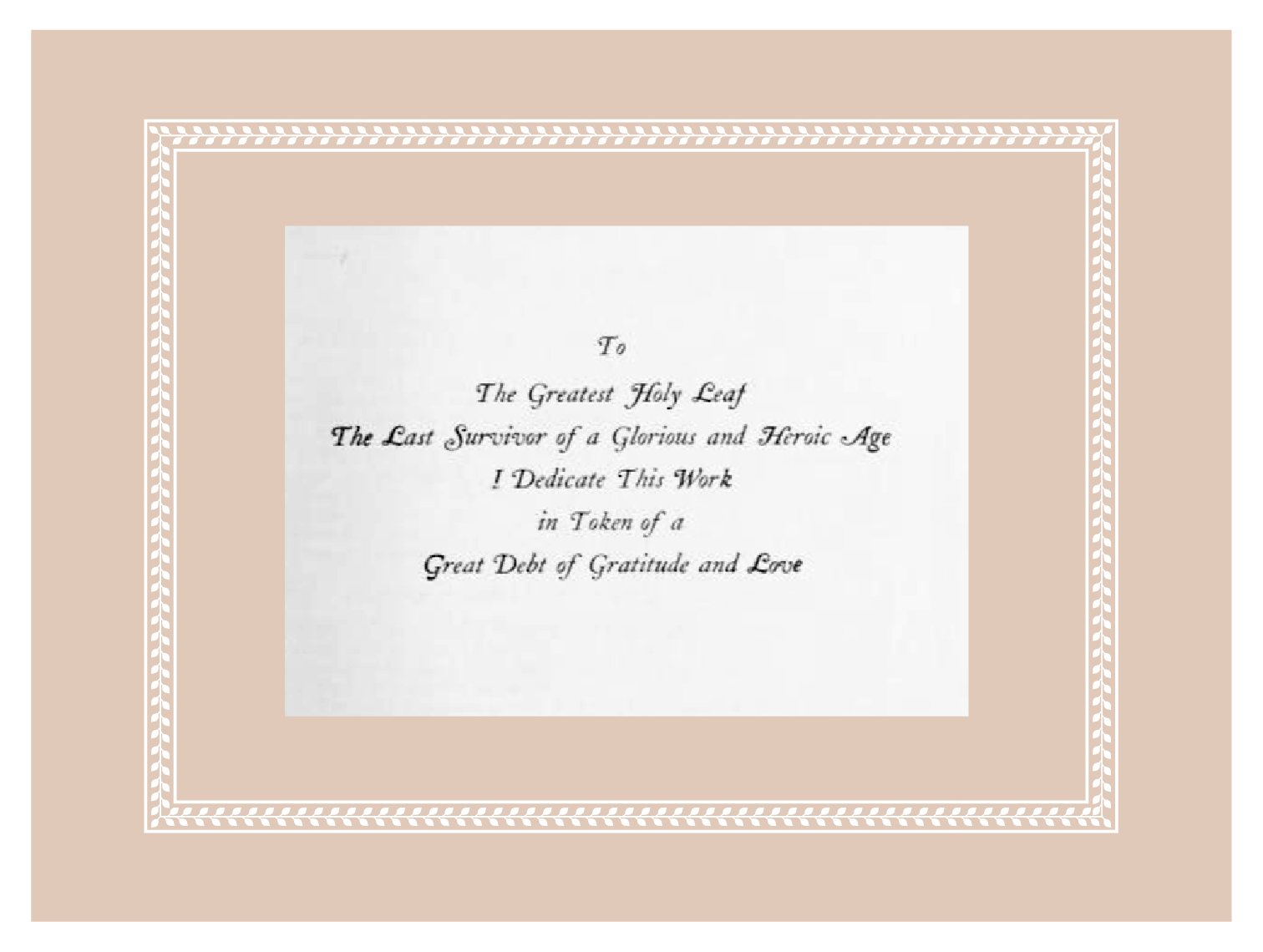
The dedication of The Dawn-Breakers.
Shoghi Effendi spent 8 backbreaking months translating and re-creating the Persian masterpiece of Nabíl’s Narrative into English. When the Guardian was done, The Dawn-Breakers was a true masterpiece.
Shoghi Effendi had added with 26 thematic chapters and included a table of contents, an introduction, and an epilogue, 300 pages of footnotes, three genealogies, and several historical essays for content and background information as well as 150 historical photographs of places and relics relevant to the narrative, and a true treasure of 20 full-color facsimiles of Tablets to the Letters of Living and to Bahá'u'lláh in the Báb’s own handwriting.
At last, Shoghi Effendi finally had a gift worthy of the Greatest Holy Leaf, the last survivor of that Age and a first-hand witness of many of the events described in The Dawn-Breakers.
Shoghi Effendi dedicated the work to Bahíyyih Khánum, the daughter of Bahá'u'lláh, the pillar of 'Abdu'l-Bahá, and his own shield and shelter, and the most important person in his life:
To
The Greatest Holy Leaf
The last Survivor of a Glorious and Heroic Age
I Dedicate This Work
In Token of a
Great Debt of Gratitude and Love
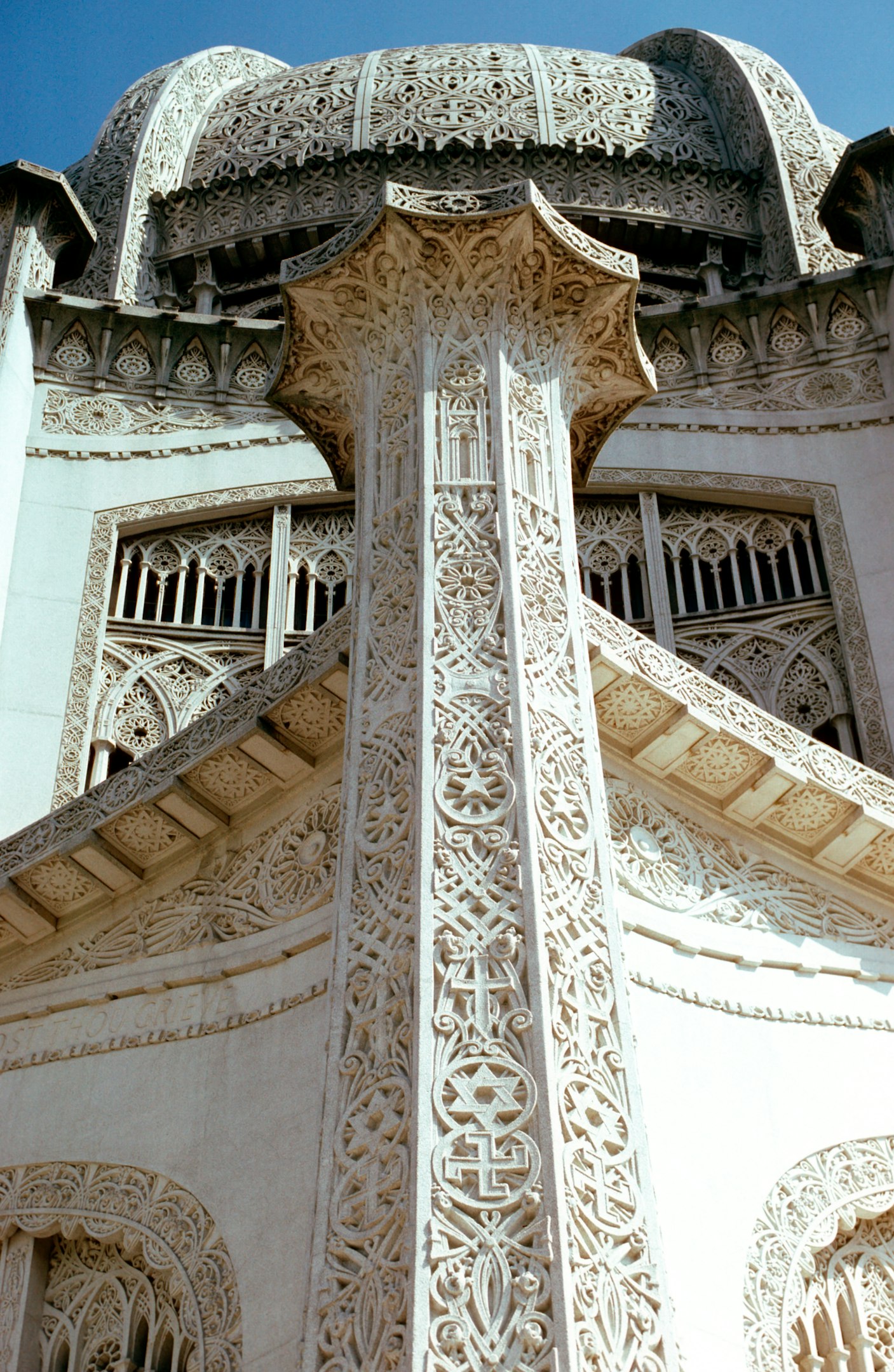
Detail of the external ornamental features of the Continental Bahá’í House of Worship of North America (Wilmette, United States), 1988. Source: Bahá'í Media Bank, © Bahá'í International Community 2024.
Sometime in the early summer of 1932, the National Spiritual Assembly of the United States and Canada had begun working on the exterior ornamentation of the North American House of Worship.
Shoghi Effendi did not miss this opportunity to congratulate them. On 10 June 1932, one month before Bahíyyih Khánum’s passing he sent them such a happy message, including the Greatest Holy Leaf in his cable:
Assembly’s momentous decision fraught with incalculable consequences, world-wide benefits. Greatest Holy Leaf filled with delight. Both devoutly praying unrelaxing determination consummate heroic enterprise. Abiding gratitude.
It is so obvious from the Guardian’s cable that both he and Bahíyyih Khánum were deeply invested in the construction process of the House of Worship of North America.
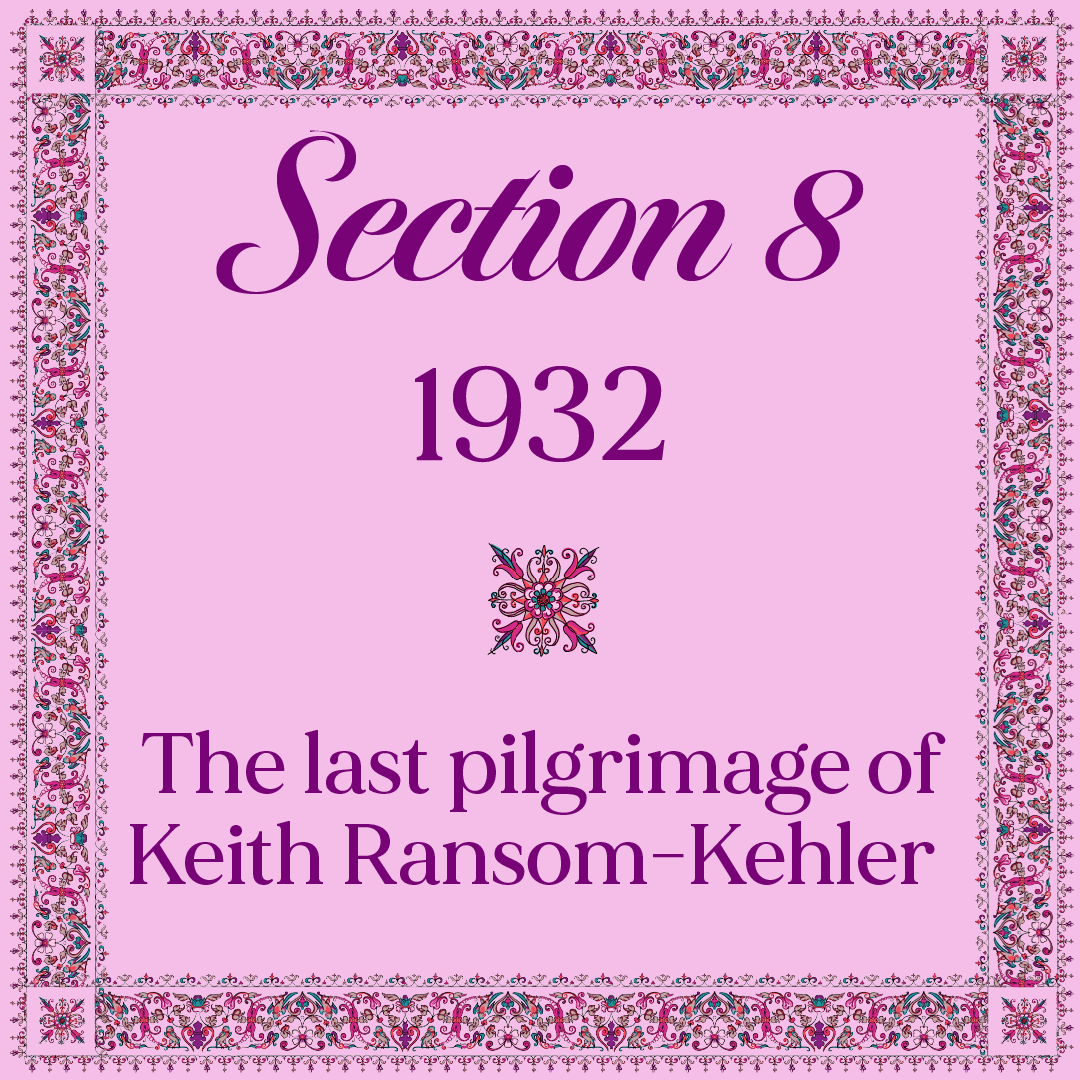
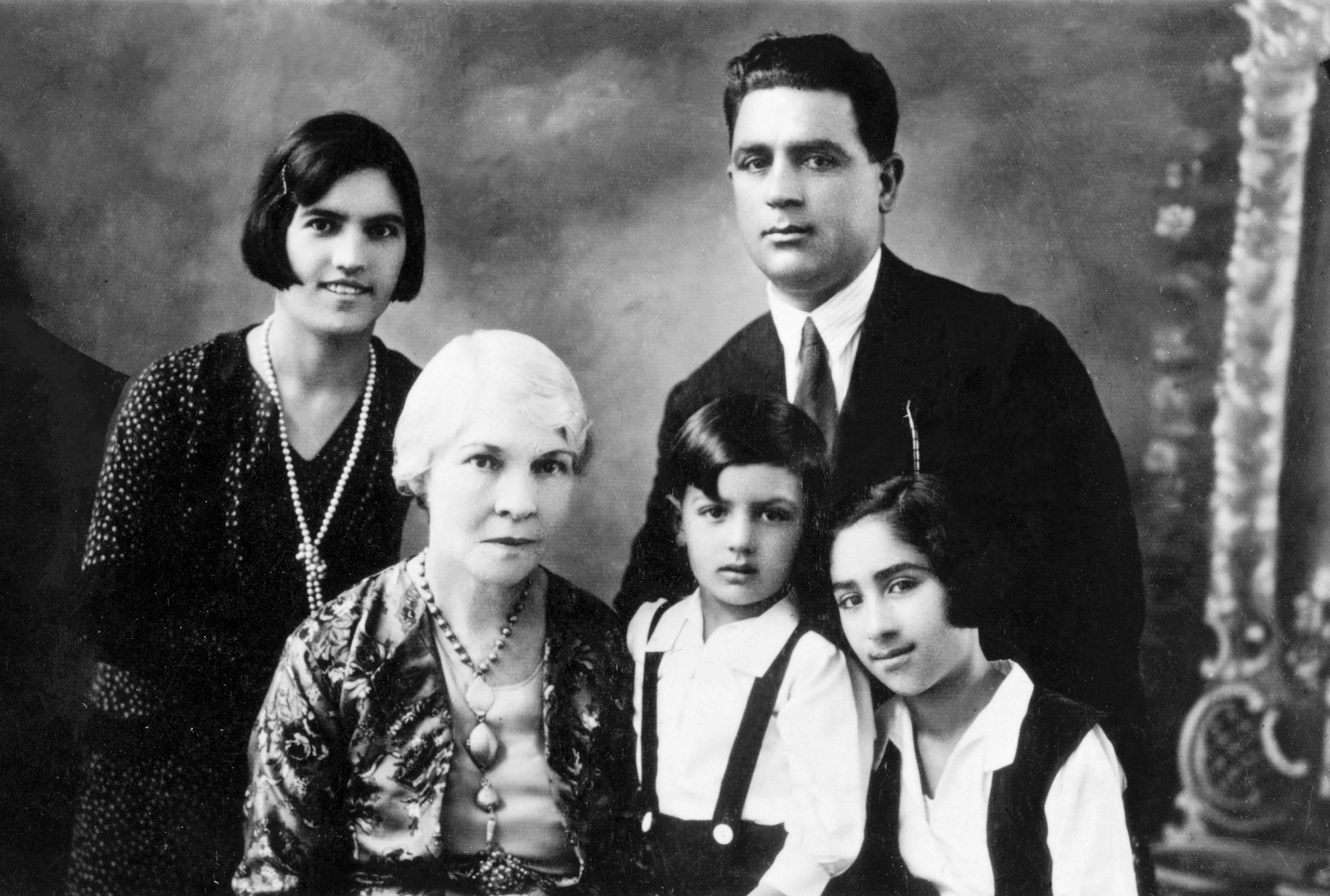
Hand of the Cause Keith Ransom-Kehler (seated at left) with Rahmatu’llah Khán ‘Ala’i (standing at right) and Najmieh (standing at left), with Gloria (right) and her brother, Manuchihr. Gloria would later become Gloria Faizi, the wife of Hand of the Cause Abu’l-Qásim Faizi. Source: Bahá'í Media Bank, © Bahá'í International Community 2024.
Keith Ransom-Kehler was an extremely distinguished woman, and a stalwart American Bahá'í. She was in India in April 1932 when the Guardian summoned her urgently to the Holy Land for a very special mission: she was to present a petition to the Sháh of Persia to allow Bahá'í literature into the country.
Keith Ransom-Kehler arrived in May 1932, two months before the passing of the Greatest Holy Leaf and so she was one of the very last western pilgrims to see Bahíyyih Khánum before her passing.
Keith did not stay very long in Haifa, maybe a couple of weeks, or three, but she was a very gifted writer and always kept a diary and her description of the Greatest Holy Leaf is a real work of literature, so it is quoted here in full:
From the Greatest Holy Leaf streamed an effulgence of beauty and heavenly love that I have never witnessed from any human being.
To come into her presence was to hush and exalt the soul.
She was like a bird at dawn, the coming of spring, a city on a far horizon; everything that wakes our wonder and reveals the depths and not the tumults of the heart.
On two occasions she removed my Bahá’í ring and after holding it for some time replaced it reversed.
Twice she blew on the palm of my hand, a sweet, cool, delicious breath and then exultantly exclaimed:
It is all right now.
Her mind was never quite clear except on the occasion of my parting.
She would reach out her delicate hand and, pressing my cheek close against her own, would make some lover-like exclamation.
I was dissolved by her sweetness.
For the most part she would chant in a low delicious voice some glorious Tablet or poem, smoothing my hand or holding me under the chin as she sang.
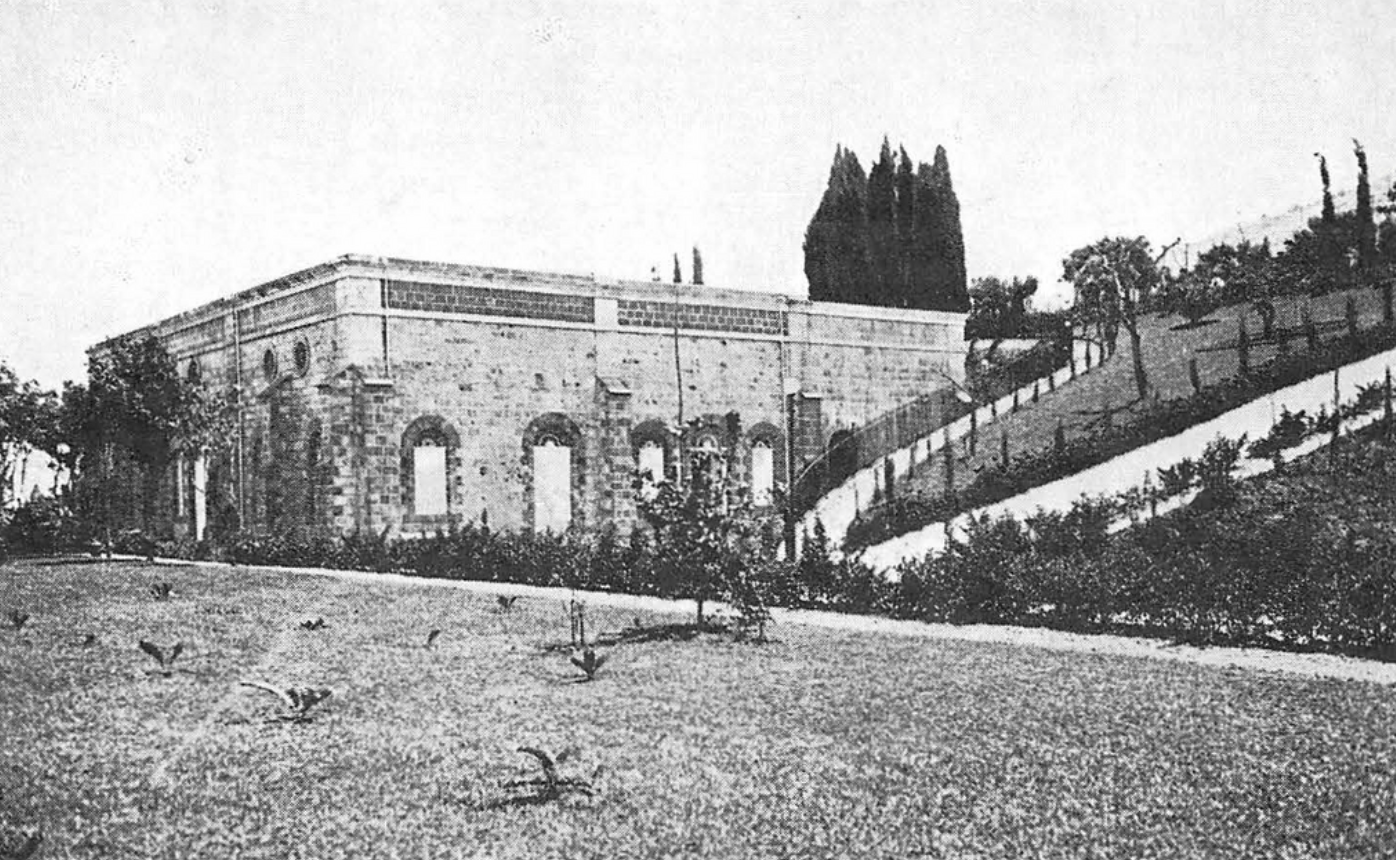
The Shrine of the Báb in the 1920s very close to how it would have appeared to the Greatest Holy Leaf during her Sunday visits in 1932. Source: Bahaimedia.
One of Keith Ransom-Kehler’s memories of her weeks in Haifa was that the Greatest Holy Leaf’s weekly visit to the Shrines of the Báb and 'Abdu'l-Bahá.
The Greatest Holy Leaf in the spring of 1932 was 86 years old.
She was two months away from her passing, and very, very frail.
Yet the Greatest Holy Leaf insisted on attending the Sunday meeting on Mount Carmel at the Shrines of the Báb and 'Abdu'l-Bahá every single Sunday.
In order for this to happy, was adamant, despite her frailty and the fact she was 86 years old and just two months before her passing.
For this to happen, careful logistics had to be in place.
The car had to come in front of the House of the Master, and the Greatest Holy Leaf had to be gently lifted into the car, then driven up to the Shrines, and again, very carefully lifted out of the car.
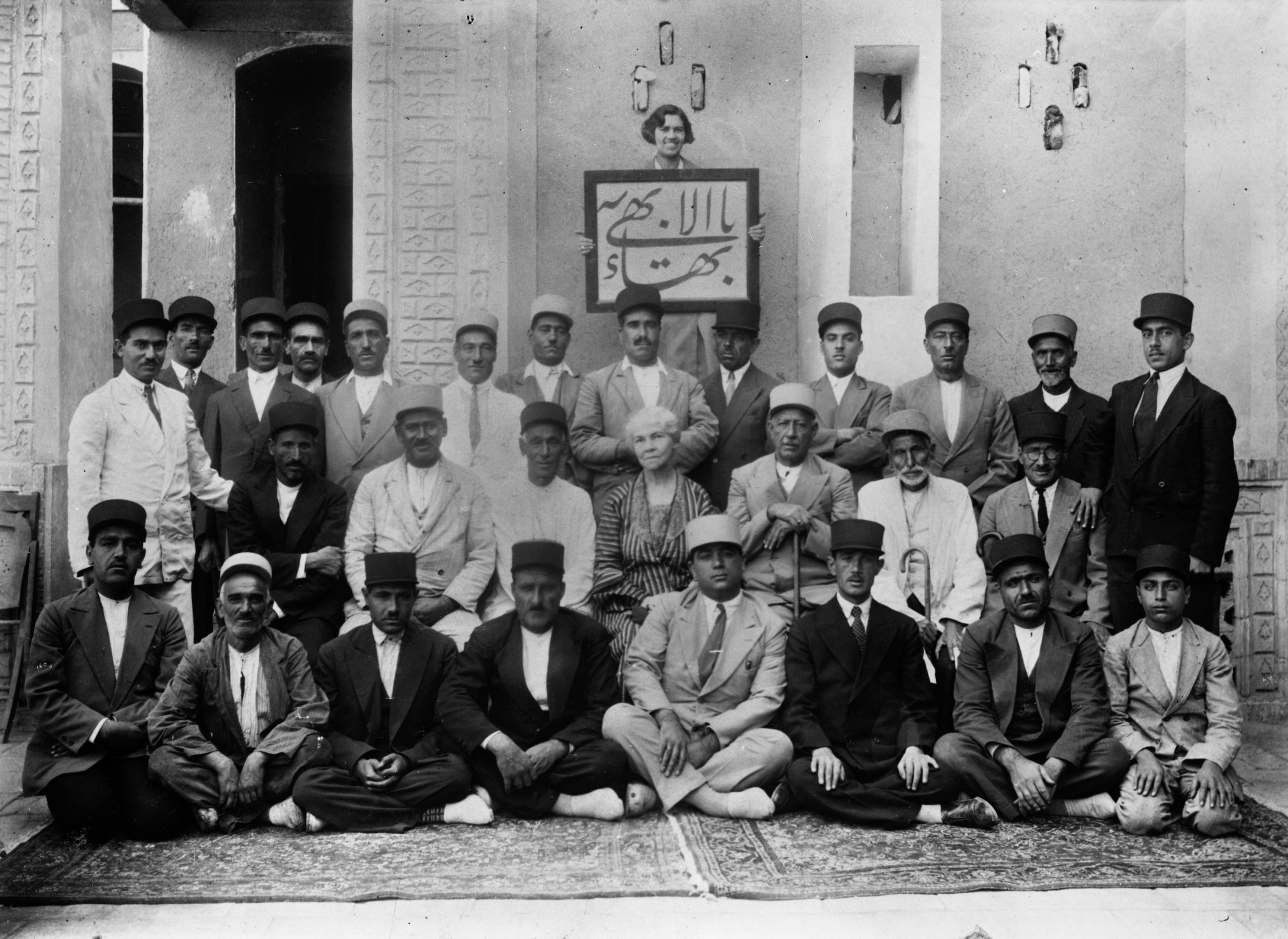
Keith Ransom-Kehler with a group of Bahá'ís in Persia in 1933. Source: Bahá'í Media Bank, © Bahá'í International Community 2024.
Shortly after the commemoration of the Ascension of Bahá'u'lláh on 29 May 1932—which Bahá'ís commemorate at 3:00 AM, the time He passed. Keith had tea with the women of the Holy Family and she noticed that the Greatest Holy Leaf seemed weak. She had kept the wake for the commemoration and it had taken its toll on her fragile body.
Keith recalled that the Greatest Holy Leaf insisted on visiting the Shrines of the Báb and 'Abdu'l-Bahá on Mount Carmel every Sunday. By this late stage in her life, she was so weak she had to be lifted in and out of the car.
Keith has a beautiful entry in her diary about Bahíyyih Khánum’s spiritual qualities
Her thoughtfulness, her loving kindness, her self-mastery, her complete dedication to the things of the spirit never ceased to the last hour that I saw her, just a month and a day before her ascension.
Keith Ransom-Kehler left on 15 June 1932 for Persia. She left one month and one day before the Greatest Holy Leaf’s passing.
As Keith was saying goodbye to all the women after tea, and 'Abdu'l-Bahá’s oldest daughter, Ḍíyá‘íyyih Khánum, helped the Greatest Holy Leaf up from her seat. She would have none of Keith’s protests.
The Greatest Holy Leaf embraced Keith in her arms so very tenderly and asked her for a magnificent and very touching favour:
When you are come to Persia, I want you to give my love to every Bahá’í in all that land, to the men the same as to the women. And when you reach the holy city of Tihrán enter it in my name, and teach there in my name.
The Greatest Holy Leaf never lost her vital link with the country and city of her birth, and she wanted someone going to the places she could never again visit to bring a piece of her love back to them. That was the Greatest Holy Leaf’s utter thoughtfulness.
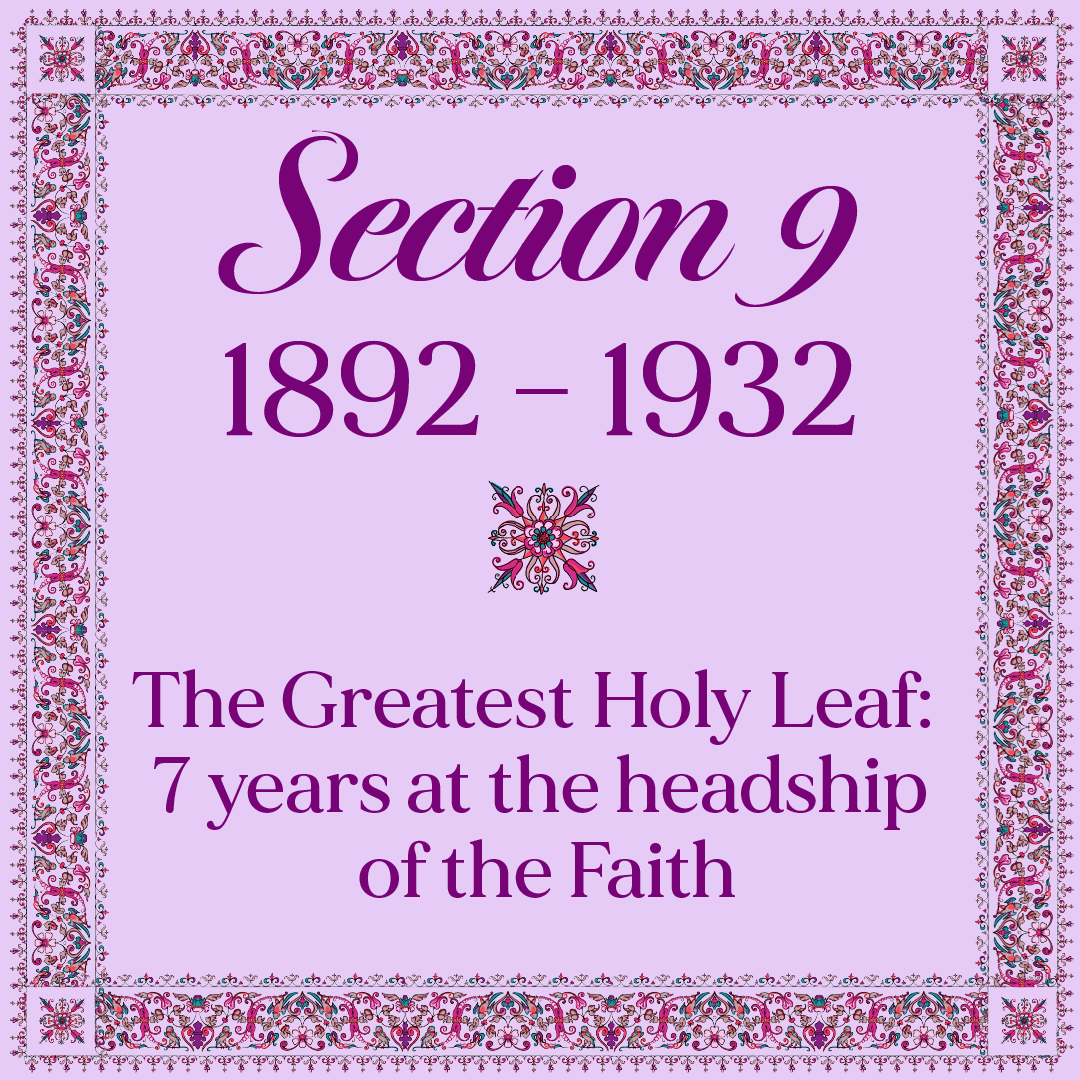
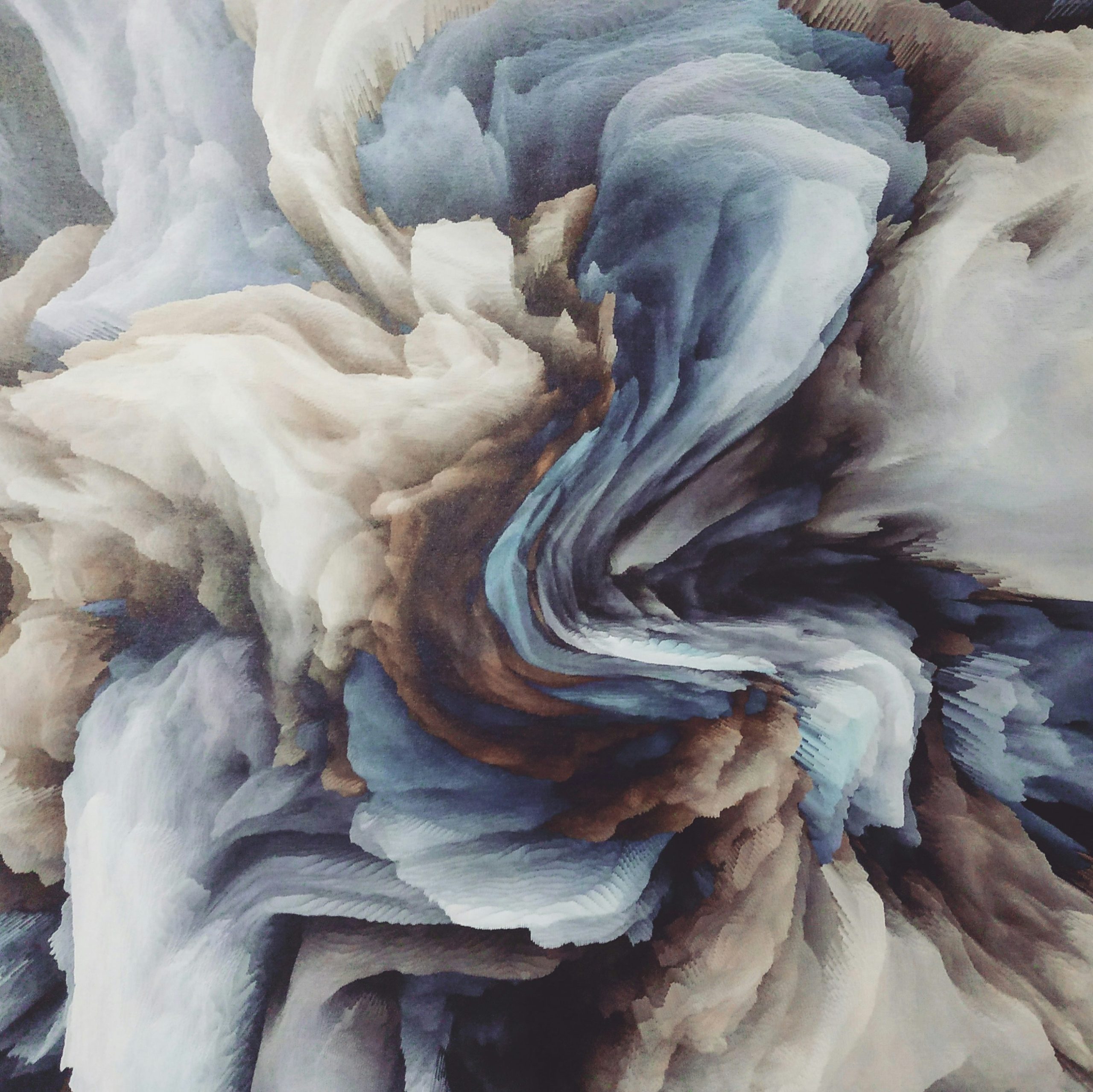
Photo by Orfeas Green on Unsplash.
In 1892 and 1921, when the Greatest Holy Leaf experienced the two most devastating losses of her life—her Father, Bahá'u'lláh, and her beloved Brother, 'Abdu'l-Bahá—she was there to support 'Abdu'l-Bahá and Shoghi Effendi as they respectively assumed the mantle of Center of the Covenant and Guardian of the Faith of Bahá'u'lláh, in the midst of their astounding grief.
For 50 years during the ministries of 'Abdu'l-Bahá and Shoghi Effendi, during all their absences, it was the Greatest Holy Leaf who eased their minds, burdened by the sorrows of their station as Center of the Covenant and Guardian.
Because the Greatest Holy Leaf was there, at their side, a capable and brilliant leader with a stainless character, Shoghi Effendi and 'Abdu'l-Bahá were able to attend to their health, proclaim the Cause of Bahá'u'lláh, and leave the Bahá'í World Centre.
All told, the Greatest Holy Leaf single-handedly held the center of the Faith, protected the Cause from Covenant-breakers, defended the persecuted Bahá'ís in Persia, managed the affairs of the local Bahá'í community, welcomed the pilgrims, all while still attending to her duties as head of the household of the Holy Family for a period of nearly 8 years.
This figure may seem extraordinary, but it is based on historical, dated facts of the 12 known absences of the Master and the 9 known absences of the Guardian.
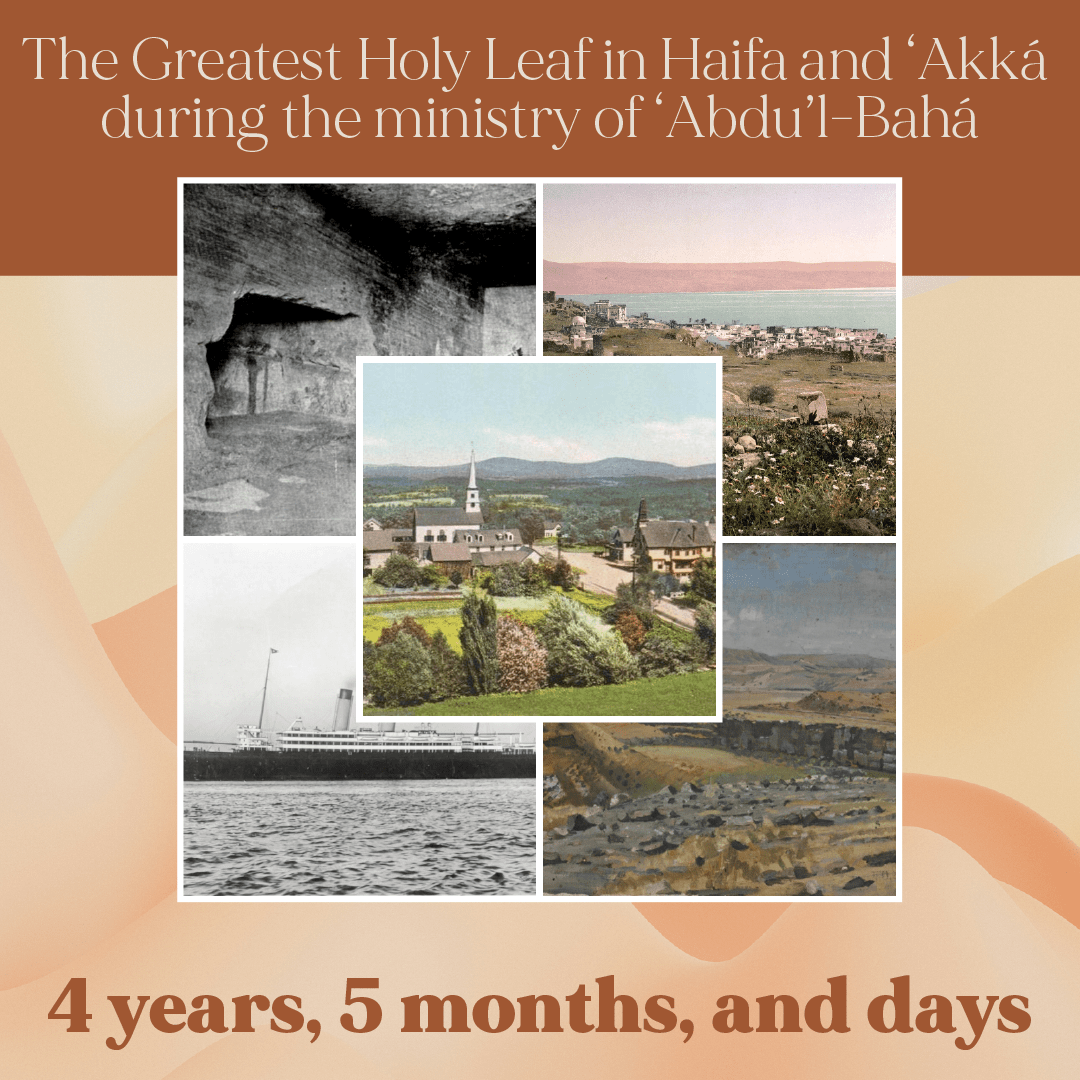
A collage of places 'Abdu'l-Bahá visited during His ministry. Collage created with https://pixlr.com/photo-collage/. Background photo by Pawel Czerwinski on Unsplash.
The Greatest Holy Leaf was 'Abdu'l-Bahá’s trusted deputy for a total of 4 years, 5 months, and 7 days between 1892 and 1921.
Below are the 12 known absences of 'Abdu'l-Bahá from 'Akká and Haifa during His ministry:
|
Number |
Date |
Duration |
Location |
|
1 |
Summer 1892 |
1 month |
Abdu’l-Bahá in the cave of Elijah on Mount Carmel after the Ascension of Bahá'u'lláh |
|
2 |
1895 - 1896 |
Estimate of 6 months |
'Abdu'l-Bahá in Tiberias “for a considerable period” according to historian Baharieh Maani |
|
3 |
November 1896 to January 1897 |
2 months |
Abdu'l-Bahá retreat to the Cave of Elijah shortly before the birth of Shoghi Effendi |
|
4 |
29 August 1910 to 5 December 1913 |
3 years, 3 months, 6 days |
'Abdu'l-Bahá’s journeys to the west |
|
5 |
Early 1916 |
1 day |
Abdu'l-Bahá visits Nazareth during the war for a single day. |
|
6 |
End of March 1916 |
7 days |
Abdu'l-Bahá visits 'Adasiyyih for one week |
|
7 |
1 to 16 May 1916 |
15 days |
‘Abdu'l-Bahá visits Al-Hammah hot springs and on 16 May spends the day in 'Adasiyyih |
|
8 |
17 May to 15 June 1916 |
28 days |
Abdu'l-Bahá visits Tiberias |
|
9 |
July 1917 |
15 days |
Abdu'l-Bahá visits 'Adasiyyih for 15 days |
|
10 |
1914 - 1918 |
Estimate of 4 weeks |
During the war, 'Abdu'l-Bahá visited Tiberias and Adasíyyih, the Yarmuk and Jordan Valleys many times, sometimes staying for long periods of time. |
|
11 |
1920 |
1 day |
Abdu'l-Bahá visits 'Adasiyyih for one day and done night |
|
12 |
3 March - 30 April 1921 |
1 month and 3 days |
Abdu'l-Bahá visits Tiberias |
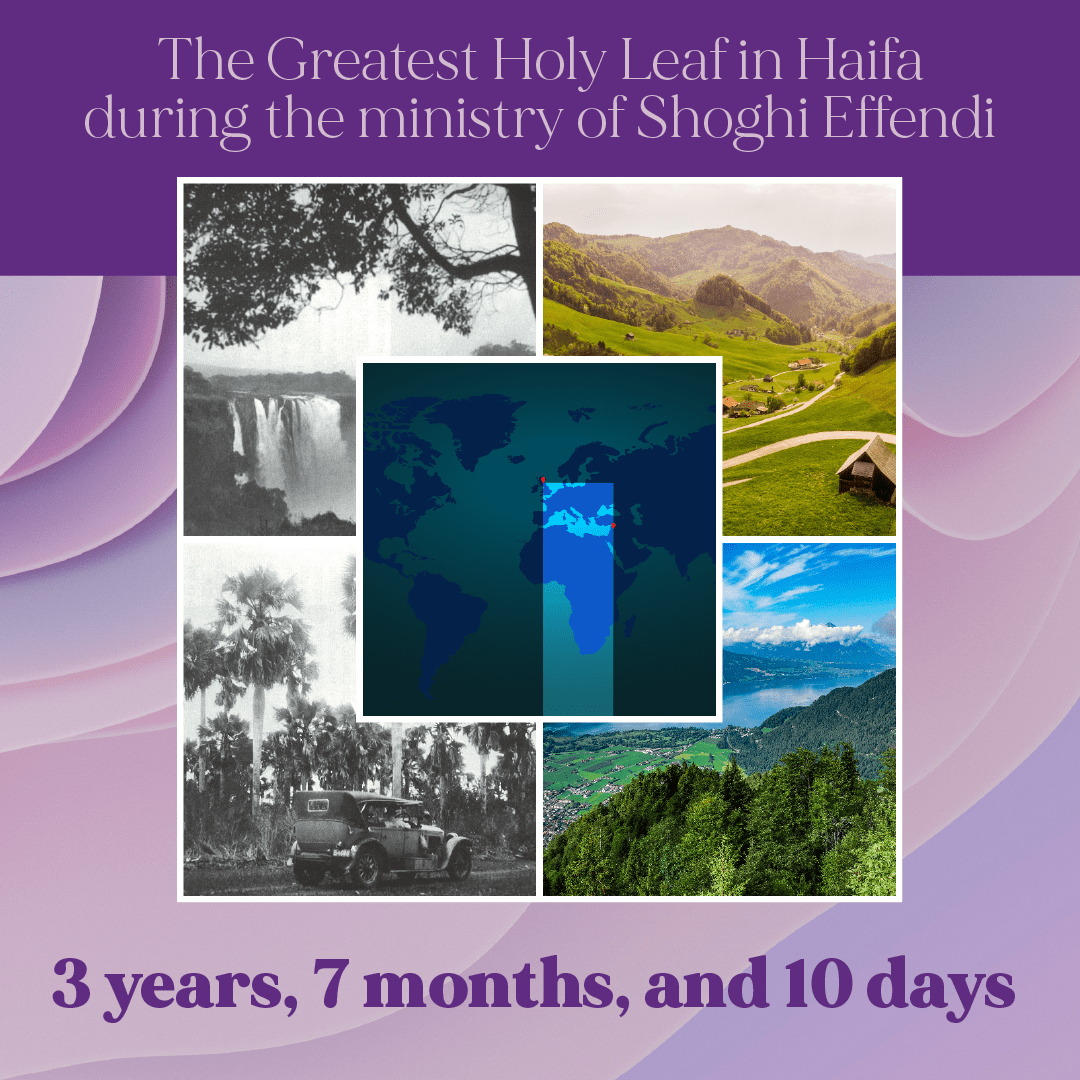
A collage of places Shoghi Effendi visited during His ministry. Collage created with https://pixlr.com/photo-collage/. Background photo by Pawel Czerwinski on Unsplash
The Greatest Holy Leaf was at the headship of the Faith for a total of 3 years, 7 months, and 10 days between 1921 and 1932.
Below are the 8 known absences of Shoghi Effendi from Haifa during His Guardianship:
|
Number |
Date |
Duration |
Location |
|
1 |
28 November 1921 - 30 December 1921 |
1 month |
Between the Ascension of 'Abdu'l-Bahá and Shoghi Effendi's arrival in the Holy Land |
|
2 |
5 April to 15 December 1922 |
8 months and 10 days |
Shoghi Effendi’s first summer retreat to Switzerland after the Ascension of 'Abdu'l-Bahá |
|
3 |
June to November 1923 |
5 months |
Shoghi Effendi’s second summer retreat to Switzerland |
|
4 |
Mid-March to 24 September 1924 |
6 months and 15 days |
Shoghi Effendi’s third summer retreat to Switzerland. We know Shoghi Effendi was in Haifa on 20 October when Florence and ‘Alí Quli Khan arrived on pilgrimage |
|
5 |
May to October 1925 |
5 months |
Shoghi Effendi’s fourth summer retreat to Switzerland |
|
6 |
May to 15 October 1926 |
5 months |
Shoghi Effendi’s fifth summer retreat to Switzerland |
|
7 |
June to November 1927 |
5 months |
Shoghi Effendi’s sixth summer retreat to Switzerland |
|
8 |
Summer - October 1929 |
5 months |
Shoghi Effendi travels to England, then overland from Cape Town to Cairo and Haifa |
|
9 |
May to July 1932 |
2 months |
Shoghi Effendi’s summer retreat to Switzerland. The Greatest Holy Leaf passed away while he was there, on 15 July 1932. |
There are at least four reasons why the figure of Bahíyyih Khánum alone at the head of the Faith could be higher:
1) In 1895 – 1896—when 'Abdu'l-Bahá was absent from 'Akká for a considerable amount of time that could have been as many as 10 months, but for the purposes of caution, the estimate for His absence during this time when He was in Tiberias was capped at 6 months.
2) 'Abdu'l-Bahá traveled to Beirut after the Ascension of Bahá'u'lláh and wrote Bahíyyih Khánum letters, but there is no indication of what year, or how long 'Abdu'l-Bahá was absent from the Holy Land;
3) During World War I from 1914 to 1918, 'Abdu'l-Bahá traveled regularly to Tiberias, ‘Adasiyyíh, and His other villages in the Jordan and Yarmuk Valleys around the Sea of Galilee. These absences could very well have added up to several month but for the purposes of caution, they were capped at 4 weeks.
4) Finally, the most obvious reason is that it is likely there are many absences of 'Abdu'l-Bahá and even perhaps Shoghi Effendi, of which we are not aware.
I have made available an Excel spreadsheet containing both my reference for the absences of 'Abdu'l-Bahá and Shoghi Effendi from 'Akká and Haifa, as well as the duration of their absences. Some of these durations are exact and others are approximate.
You can download this spreadsheet by simply clicking on the graphic below:
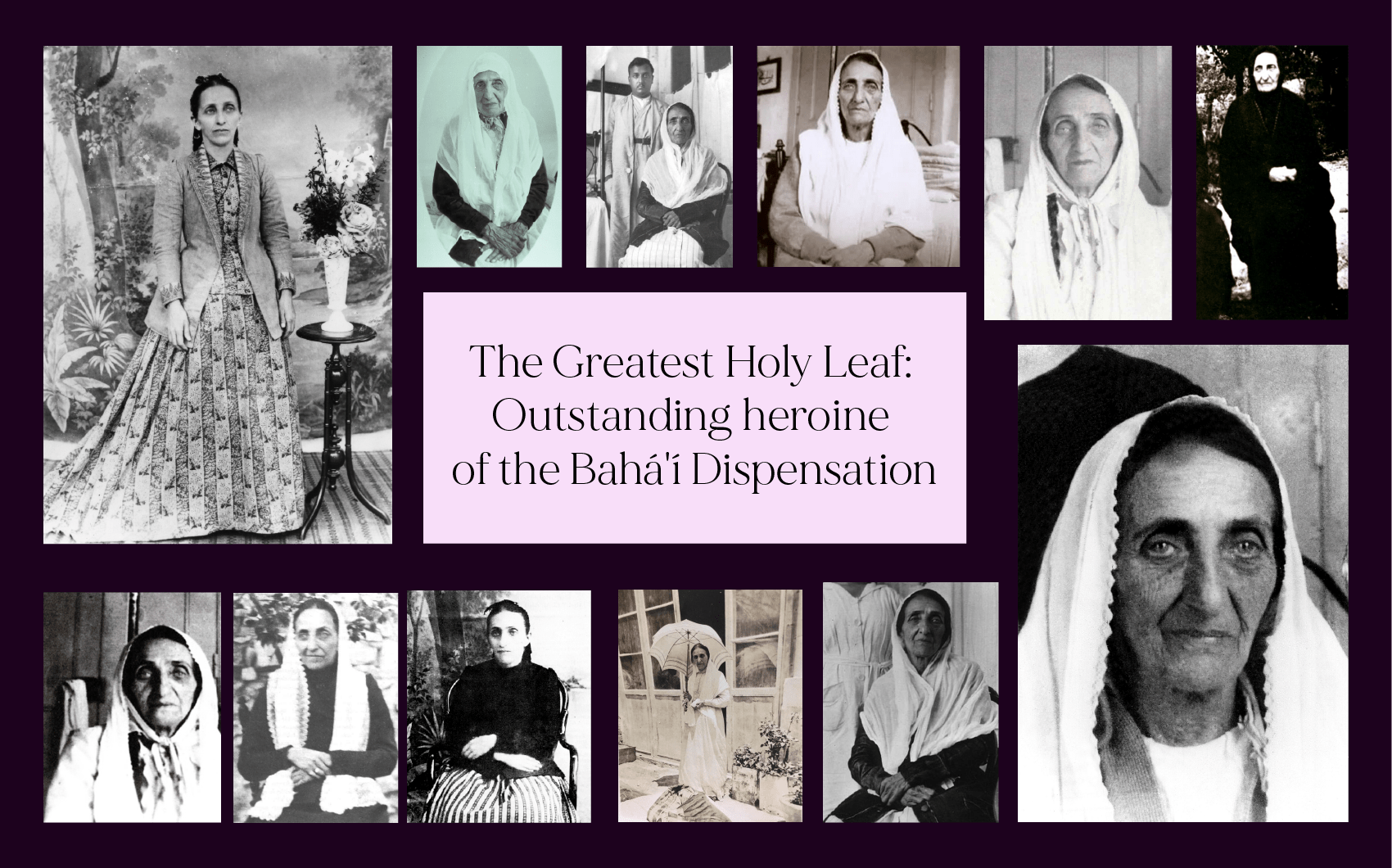
A collage of all the photos of the Greatest Holy Leaf currently known.
For 86 years, Bahíyyih Khánum quietly but passionately served Bahá'u'lláh, 'Abdu'l-Bahá, and Shoghi Effendi. The Supreme Manifestation for this Age, the Center of His Covenant, and the Guardian of His Faith.
The Greatest Holy Leaf lived such a humble, self-effacing and private life, serving quietly and constantly, most often inside her home that no one really knew her the way Bahá'u'lláh, 'Abdu'l-Bahá, and the Guardian knew her.
She was a spiritual giant, and she had the station of Outstanding Heroine of the Bahá'í Dispensation, but during her lifetime, hundreds or maybe even thousands of people passed by her without knowing the loftiness of her spiritual rank.
She served.
She had a very quiet, reserved character, and did not speak excessively, so it was easy for the thousands of pilgrims who came to the Holy Land not to really understand her extraordinary role in the Faith from the beginning of the Bábí Dispensation.
Bahíyyih Nakhjávání in her tribute to the Greatest Holy Leaf on the fiftieth commemoration of her passing, said:
The greatness of [the Greatest Holy Leaf’s] station can only be measured by her obedience and her love for the Covenant of God. Her obedience and love for the Covenant is what ensured her proximity to the Centre of the Covenant throughout her life, and that proximity surely cannot be measured except by some reflection on the degree to which she suffered.
The Guardian, live his entire life completely aware of his great-aunt’s spiritual destiny.
He loved her with the a love which completely encompassed both his relationship to her as his great-aunt, and the awareness of her rank as the daughter of Bahá'u'lláh. He always knew her unique place in Bahá'í history, the lifelong role she played in influencing the course of major events in the history of the Heroic Age of the Faith, the overwhelming sacrifices she had made, her heartbreaking suffering she had endured and her excessively rare virtues of loyalty, dedication, steadfastness in the Covenant.
The Guardian once said that one day, in the future, the world would “recognize its irreparable loss.”
That day was coming.
SOURCES FOR PART XII
The Greatest Holy Leaf’s qualities of character
The Passing of Bahíyyih Khánum by Marjorie Morten, Bahá’í News Issue 497 pages 5-7 (August 1972)
The Greatest Holy Leaf’s presence
Leaves of the Twin Divine Trees, Baharieh Rouhani Ma’ani, George Ronald, Oxford, 2013, pages 220-223.
The Greatest Holy Leaf’s resilience
Leaves of the Twin Divine Trees, Baharieh Rouhani Ma’ani, George Ronald, Oxford, 2013, page 224.
1926/1927: ‘Alí Nakhjávání and the “Mouthful of Khánum”
The Greatest Holy Leaf: A Reminiscence, ‘Alí Nakhjávání, published in The Bahá’í World, Volume 18 (1979-1983), pages 59-67.
The story of the two silver shillings
The Greatest Holy Leaf: A Reminiscence, ‘Alí Nakhjávání, published in The Bahá’í World, Volume 18 (1979-1983), pages 59-67.
The Nakhjávání boys and the Greatest Holy Leaf’s sweets
The Greatest Holy Leaf: A Reminiscence, ‘Alí Nakhjávání, published in The Bahá’í World, Volume 18 (1979-1983), pages 59-67.
Undated: Bahíyyih Khánum and the Muslim wife
A Gift of Love: Offered to the Greatest Holy Leaf by Abu’l-Qásim Faizi, compiled and edited by Gloria A. Faizi, 1982, pages 25-26.
1927: Abu’l-Qásim Faizí’s memories of Bahíyyih Khánum
A Gift of Love: Offered to the Greatest Holy Leaf by Abu’l-Qásim Faizi, compiled and edited by Gloria A. Faizi, 1982, pages 33-34.
DATE:
Shoghi Effendi Through the Pilgrim’s Eye Volume 1 Building the Administrative Order, 1922-1952. Earl Redman, George Ronald, Oxford, 2015: 1927: Another future Hand of the Cause
1927: Abu’l-Qásim Faizi chants for the Greatest Holy Leaf
A Gift of Love: Offered to the Greatest Holy Leaf by Abu’l-Qásim Faizi, compiled and edited by Gloria A. Faizi, 1982, pages 32 and 34.
Perhaps 1928: The American University in Beirut students’ second program for the Greatest Holy Leaf
A Gift of Love: Offered to the Greatest Holy Leaf by Abu’l-Qásim Faizi, compiled and edited by Gloria A. Faizi, 1982, page 35.
Wikipedia: Tar (string instrument).
Ethnic Musical: Tar, a mysterious instrument.
A Gift of Love: Offered to the Greatest Holy Leaf by Abu’l-Qásim Faizi, compiled and edited by Gloria A. Faizi, 1982, page 35.
The Greatest Holy Leaf and the laborers’ song
A Gift of Love: Offered to the Greatest Holy Leaf by Abu’l-Qásim Faizi, compiled and edited by Gloria A. Faizi, 1982, pages 35-37.
A Gift of Love: Offered to the Greatest Holy Leaf by Abu’l-Qásim Faizi, compiled and edited by Gloria A. Faizi, 1982, pages 35-37.
The Priceless Pearl, Rúḥíyyih Rabbání, Bahá’í Publishing Trust, London, 1969, pages 113-116.
Queen Marie and the Baha’i Faith, Robert Postlethwaite, pages 76-77 and 79.
Prophet’s Daughter: The Life and Legacy of Bahíyyih Khánum, Outstanding Heroine of the Bahá’í Faith, Janet A. Khan, Bahá’í Publishing Trust, Wilmette, 2005, page 195.
30 March 1930: The missed visit of Queen Marie of Romania
The Priceless Pearl, Rúḥíyyih Rabbání, Bahá’í Publishing Trust, London, 1969, pages 113-116.
Queen Marie and the Baha’i Faith, Robert Postlethwaite, pages 76-77 and 79.
1926 – 1938: The Greatest Holy Leaf and Queen Marie of Romania
Her Eternal Crown: Queen Marie of Romania and the Bahá’í Faith, Della L. Marcus, George Ronald, Oxford, 2000, pages 25, 102, 108-109, 130-131, 199, 201, 226-227
27 November 1929: The Greatest Holy Leaf obtains the keys to the Mansion of Bahjí
The Priceless Pearl, Rúḥíyyih Rabbání, Bahá’í Publishing Trust, London, 1969, page 233. Leaves of the Twin Divine Trees, Baharieh Rouhani Ma’ani, George Ronald, Oxford, 2013, pages 202-204.
Wives of Baha’u’llah, Letter dated 23 October 1995 on behalf of the Universal House of Justice.
Bahá’í Library Online chronology: Bahjí.
Bahá’í News, Issue 42 (July 1930).
God Passes By, Shoghi Effendi.
The Extraordinary Life of ‘Abdu’l-Bahá Part VIII: The Return to the Holy Land, September – November 1921 – HAIFA – ‘Abdu’l-Bahá brings electricity to the Holy Places.
Bahá’í News, Issue 53 (July 1931).
Shoghi Effendi: Recollections, Ugo Giachery, George Ronald, 1973, page 123.
1930: Lady Blomfield interviews Bahíyyih Khánum
The Chosen Highway, Lady Blomfield, Bahá’í Publishing Trust, Wilmette, Ill. 1975, page 46.
‘Abdu’l-Bahá: Center of the Covenant, H.M. Balyuzi, George Ronald, Oxford, 1971, pages 13-14.
The Priceless Pearl, Rúḥíyyih Rabbání, Bahá’í Publishing Trust, London, 1969, page 233. Leaves of the Twin Divine Trees, Baharieh Rouhani Ma’ani, George Ronald, Oxford, 2013, Kindle Edition, Chapter 7: Bahá’íyyih Khánum, the Most Outstanding Heroine of the Bahá’í Dispensation.
Wives of Baha’u’llah, Letter dated 23 October 1995 on behalf of the Universal House of Justice.
Bahá’í Library Online chronology: Bahjí.
Bahá’í News, Issue 42 (July 1930).
God Passes By, Shoghi Effendi.
The Extraordinary Life of ‘Abdu’l-Bahá Part VIII: The Return to the Holy Land, September – November 1921 – HAIFA – ‘Abdu’l-Bahá brings electricity to the Holy Places.
Bahá’í News, Issue 53 (July 1931).
Shoghi Effendi: Recollections, Ugo Giachery, George Ronald, 1973, page 123.
1931: Effie Baker takes the last photograph of the Greatest Holy Leaf
Ambassador at the Court: The Life and Photography of Effie Baker, Graham Hassall, Chapter 7: England, Chapter 8: Pilgrim Hostel Hostess and Chapter 9: Photography.
1931: Shoghi Effendi dedicates The Dawn-Breakers to the Greatest Holy Leaf
The Priceless Pearl, Rúḥíyyih Rabbání, Bahá’í Publishing Trust, London, 1969, pages 216-218.
10 June 1932: Work begins on the exterior ornamentation of the North American House of Worship
Prophet’s Daughter: The Life and Legacy of Bahíyyih Khánum, Outstanding Heroine of the Bahá’í Faith, Janet A. Khan, Bahá’í Publishing Trust, Wilmette, 2005, page 199.
May 1932 – 15 June 1932: Keith Ransom-Kehler’s last memories of Bahíyyih Khánum
Shoghi Effendi Through the Pilgrim’s Eye Volume 1 Building the Administrative Order, 1922-1952. Earl Redman, George Ronald, Oxford, 2015: 1932: Keith Ransom-Kehler.
Prophet’s Daughter: The Life and Legacy of Bahíyyih Khánum, Outstanding Heroine of the Bahá’í Faith, Janet A. Khan, Bahá’í Publishing Trust, Wilmette, 2005, pages 206-208.
Spring 1932: The Greatest Holy Leaf’s Sunday visit to the Shrines of the Báb and ‘Abdu’l-Bahá
The Greatest Holy Leaf: A Reminiscence, ‘Alí Nakhjávání, published in The Bahá’í World, Volume 18 (1979-1983), pages 59-67.
The Greatest Holy Leaf to Keith Ransom-Kehler: “When you are come to Persia”
Shoghi Effendi Through the Pilgrim’s Eye Volume 1 Building the Administrative Order, 1922-1952. Earl Redman, George Ronald, Oxford, 2015: 1932: Keith Ransom-Kehler.
Prophet’s Daughter: The Life and Legacy of Bahíyyih Khánum, Outstanding Heroine of the Bahá’í Faith, Janet A. Khan, Bahá’í Publishing Trust, Wilmette, 2005, pages 206-208.
1892 – 1932: Fifty years of protecting the center of the Faith
Violetta Zein: own research and analysis.
1892 – 1921: Bahíyyih Khánum as ‘Abdu’l-Bahá’s trusted deputy during His ministry
1) Summer 1892: Abdu’l-Bahá in the cave of Elijah on Mount Carmel after the Ascension of Bahá’u’lláh. Source: Ruhe, David. Door of Hope: The Bahá’í Faith in the Holy Land, page 55
2) 1895 – 1896: ‘Abdu’l-Bahá in Tiberias « a considerable amount of time » according to Baharieh Maani. It seems from the events that happened in ‘Akká that ‘Abdu’l-Bahá might have been absent almost 10 months. He missed the wedding of the parent of Shoghi Effendi in early 1896 and was in ‘Akká by October 1896 when He rented the House of ‘Abdu’lláh Pasha. Because this absence of ‘Abdu’l-Bahá was so lengthy, and even though we do not have exact dates, we have made the decision to include it by greatly reducing its estimate from nearly a year to 6 months. The true figure is probably higher. Source: Maani, Baharieh Rouhani. Leaves of the Twin Divine Trees: an in-depth study of the lives of women closely related to the Báb and Bahá’u’lláh pages 329-331
3) November 1896 to January 189: Abdu’l-Bahá retreat to the Cave of Elijah shortly before the birth of Shoghi Effendi: Rabbani, Ahang. Memories of My Life: Translation of Mírzá Habíbu’lláh Afnán’s Khátirát-i-Hayát page 331
4) 29 August 1910 to 5 December 1913: ‘Abdu’l-Bahá’s journeys to the West by country, from 1910 to 1913: Haifa, Egypt, France, Switzerland, France, Switzerland, France, Switzerland, England, France, Egypt, The United States, Canada, The United States, England, Scotland, England, France, Germany, Hungary, Austria, France, Egypt, and back to Haifa. Source: Date of departure of 29 August 1920: Letter from the Universal House of Justice on 29 August 2010 commemorating the centenary of ‘Abdu’l-Bahá’s departure from Haifa to Egypt and quoting: “29 August 2010, To the Bahá’ís of the World, Dearly loved Friends, ‘Abdu’l‑Bahá’s departure one hundred years ago from Haifa for Port Said signalled the opening of a glorious new chapter in the annals of the Faith.”; Return to Haifa on 5 December 1913 from The Diary of Ahmad Sohrab, 5 December 1913.
5) Early 1916: Abdu’l-Bahá visits Nazareth during the war for a single day. Source: Hasan M. Balyuzi: ‘Abdu’l-Bahá: The Centre of the Covenant of Bahá’u’lláh pages 413-414.
6) End of March 1916: Abdu’l-Bahá visits ‘Adasiyyih for one week. Source: Iraj Poostchi. 2010. ‘Adasiyyah: A Study in Agriculture and Rural Development. Baha’i Studies Review 16, pp. 61–105.
7) 1 to 16 May 1916: ‘Abdu’l-Bahá visits Al-Hammah hot springs and on 16 May spends the day in ‘Adasiyyih. Source: The Diary of Ahmad Sohrab, 1-16 May 1914 for ‘Abdu’l-Bahá’s stay in Al-Hammah
8) 17 May to 15 June 1916: ‘Abdu’l-Bahá visits Tiberias. Source: The Diary of Ahmad Sohrab, 17 May – 15 June 1914 for ‘Abdu’l-Bahá’ visit to Tiberias. Source: Hasan M. Balyuzi: ‘Abdu’l-Bahá: The Centre of the Covenant of Bahá’u’lláh pages 413-414.
9) July 1917: Abdu’l-Bahá visits ‘Adasiyyih for 15 days. Source: Iraj Poostchi. 2010. ‘Adasiyyah: A Study in Agriculture and Rural Development. Baha’i Studies Review 16, pp. 75–76.
10) 1914 – 1918: During the war, ‘Abdu’l-Bahá visited Tiberias and Adasíyyih, the Yarmuk and Jordan Valleys many times, sometimes staying for period of time. We have, for caution’s sake rounded this up at 4 week for the duration of the war from 1914 to 1918 but the number is most probably much higher. Source: Hasan M. Balyuzi: ‘Abdu’l-Bahá: The Centre of the Covenant of Bahá’u’lláh pages 418-419.
11) 1920: ‘Abdu’l-Bahá visits ‘Adasiyyih for one day and done night. Source: Iraj Poostchi. 2010. ‘Adasiyyah: A Study in Agriculture and Rural Development. Baha’i Studies Review 16, pp. 77-78.
12) 3 March – 30 April 1921: Abdu’l-Bahá visits Tiberias. Source: Earl Redman, Visiting ‘Abdu’l-Baha Volume 2: The Final Years, 1913–1921.
1921 – 1932: Bahíyyih Khánum at the headship of the Faith during the Guardianship
1) 28 November 1921 – 30 December 1921: Between the Ascension of ‘Abdu’l-Bahá and Shoghi Effendi’s arrival in the Holy Land. Source: No source is needed for Shoghi Effendi’s absence from the Holy Land on 28 November 1921 because he was studying at Oxford at that time. Source for the date of Shoghi Effendi’s arrival in Haifa: The Priceless Pearl, Rúḥíyyih Rabbání, Bahá’í Publishing Trust, London, 1969, page 42. “Owing to passport difficulties Shoghi Effendi cabled Haifa he could not arrive until the end of the month. He sailed from England on 16 December, accompanied by Lady Blomfield and Rouhangeze, and arrived in Haifa by train at 5.20 P.M. on 29 December from Egypt where his boat from England had docked.
2) 5 April to 15 December 1922: Shoghi Effendi’s first summer retreat to Switzerland after the Ascension of ‘Abdu’l-Bahá. Source: Date of departure: “Shoghi Effendi had already left Haifa for Europe, on 5 April,”The Priceless Pearl, Rúḥíyyih Rabbání, Bahá’í Publishing Trust, London, 1969, page 56. Date of return: “after his return to Haifa on 15 December of that same year” The Priceless Pearl, Rúḥíyyih Rabbání, Bahá’í Publishing Trust, London, 1969, page 282.
3) June to November 1923: Shoghi Effendi’s second summer retreat to Switzerland. Source: The Priceless Pearl, Rúḥíyyih Rabbání, Bahá’í Publishing Trust, London, 1969, pages 58-59 and 72.
4) Mid-March to 24 September 1924: Shoghi Effendi’s third summer retreat to Switzerland. We know Shoghi Effendi was in Haifa on 20 October when Florence and ‘Alí Quli Khan arrived on pilgrimage. Source: The Priceless Pearl, Rúḥíyyih Rabbání, Bahá’í Publishing Trust, London, 1969, page 59.
5) May to October 1925: Shoghi Effendi’s fourth summer retreat to Switzerland. Source: The Priceless Pearl, Rúḥíyyih Rabbání, Bahá’í Publishing Trust, London, 1969, page 60.
6) May to 15 October 1926: Shoghi Effendi’s fifth summer retreat to Switzerland. Source: The Priceless Pearl, Rúḥíyyih Rabbání, Bahá’í Publishing Trust, London, 1969, pages 58 and 97. Bahá’í Library Online chronology: The life of Shoghi Effendi. Ambassador at the Court: The Life and Photography of Effie Baker, Graham Hassall, Chapter 8: Pilgrim Hostel Hostess.
7) June to November 1927: Shoghi Effendi’s sixth summer retreat to Switzerland. Source: The Priceless Pearl, Rúḥíyyih Rabbání, Bahá’í Publishing Trust, London, 1969, page 58.
8) Summer – October 1929: Shoghi Effendi travels to England, then overland from Cape Town to Cairo and Haifa. Source: The Priceless Pearl, Rúḥíyyih Rabbání, Bahá’í Publishing Trust, London, 1969, page 180. Shoghi Effendi Through the Pilgrim’s Eye Volume 1 Building the Administrative Order, 1922-1952. Earl Redman, George Ronald, Oxford, 2015, Kindle Edition, Location 3704-3724.
9) May to July 1932: Shoghi Effendi’s seventh summer retreat to Switzerland. The Greatest Holy Leaf passed away while he was there, on 15 July 1932. Source: The Priceless Pearl, Rúḥíyyih Rabbání, Bahá’í Publishing Trust, London, 1969, pages 144-146.
Considerations for a higher estimate
Violetta Zein, The Extraordinary Life of ‘Abdu’l-Bahá Part VIII: Return to the Holy Land (1913-1921): Early 1916 – NAZARETH – ‘Abdu’l-Bahá visits Jamál Páshá.
Leaves of the Twin Divine Trees. Baharieh Rouhani Ma’ani, George Ronald, Oxford, 2013, Kindle Edition, Chapter 7: Bahá’íyyih Khánum, the Most Outstanding Heroine of the Bahá’í Dispensation.
Sources for the Greatest Holy Leaf’s 7+ years at the headship of the Faith
The Greatest Holy Leaf: Outstanding heroine of the Bahá’í Dispensation
Leaves of the Twin Divine Trees. Baharieh Rouhani Ma’ani, George Ronald, Oxford, 2013, Kindle Edition, Chapter 7: Bahá’íyyih Khánum, the Most Outstanding Heroine of the Bahá’í Dispensation.
God Passes By, Shoghi Effendi.
Bahíyyih Khanum: The Greatest Holy Leaf by Bahá’u’lláh, Abdu’l-Bahá, Shoghi Effendi, and Bahíyyih Khanum compiled by Research Department of the Universal House of Justice Haifa: Bahá’í World Centre Publications, (1982),Part III: From the Writings of Shoghi Effendi.
![]()
 The Greatest Holy Leaf’s qualities of character
The Greatest Holy Leaf’s qualities of character
